
IN THIS ISSUE...
FALL 2017 VOLUME 63 NUMBER 3
PLANT SCIENCE
BULLETIN
A PUBLICATION OF THE BOTANICAL SOCIETY OF AMERICA
International Botanical
Congress a success...p. 137
Executive Director
Bill Dahl retires...p. 145
Meet BSA’s new student rep,
Chelsea Pretz...p. 174
CONGRATULATIONS TO PLANTS GRANT RECIPIENTS!
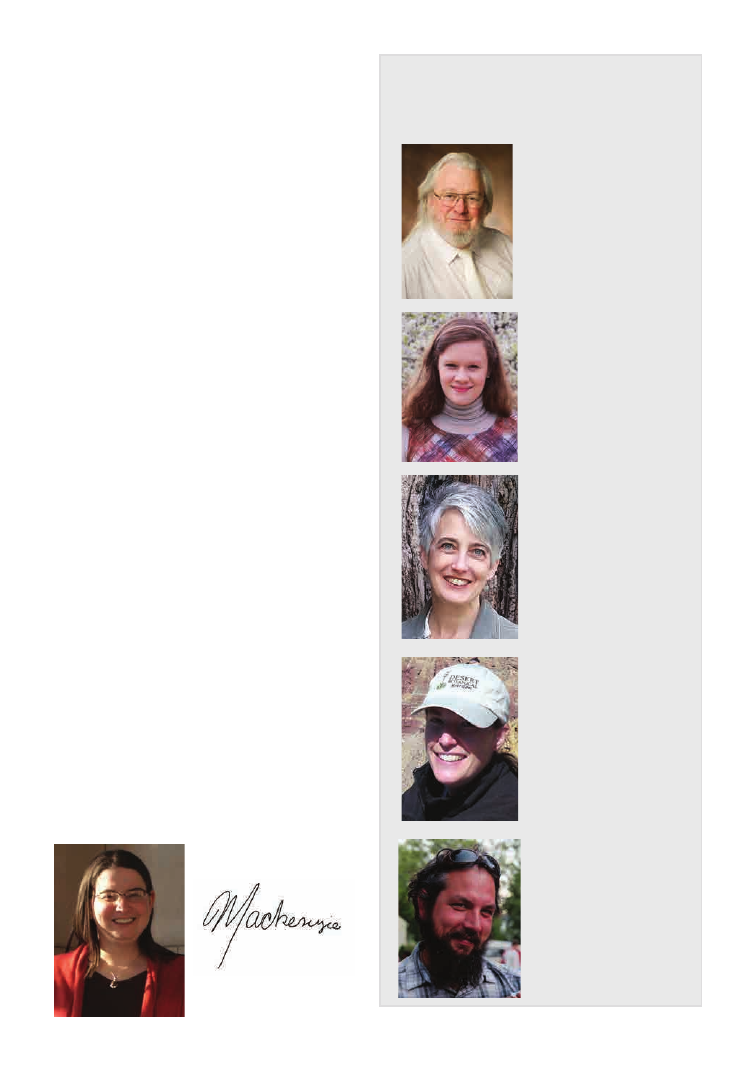
FALL 2017 Volume 63 Number 3
PLANT SCIENCE BULLETIN
Editorial Committee
Volume 63
From the Editor
Kathryn LeCroy
(2018)
Environmental Sciences
University of Virginia
Charlottesville, VA 22904
kal8d@virginia.edu
Daniel K. Gladish
(2017)
Department of Biology &
The Conservatory
Miami University
Hamilton, OH 45011
gladisdk@muohio.ed
u
Melanie Link-Perez
(2019)
Department of Botany
& Plant Pathology
Oregon State University
Corvallis, OR 97331
l
inkperm@oregonstate.edu
Shannon Fehlberg
(2020)
Research and Conservation
Desert Botanical Garden
Phoenix, AZ 85008
sfehlberg@dbg.org
David Tank
(2021)
Department of Biological
Sciences
University of Idaho
Moscow, ID 83844
dtank@uidaho.edu
Greetings,
In this issue of PSB, we bring you news of sig-
nificant change underway for the BSA. At the
end of September, long-time Executive Direc-
tor Bill Dahl retired. In this issue, Bill reflects
on his experiences with the Society and shares
his perspective on the future of the BSA. I want
to thank Bill, on behalf of PSB, for his dedica-
tion to, and direction of, the Society and for
sharing his parting thoughts with us. Heather
Cacanindin has stepped in as Interim Executive
Director.
A change is also occurring in publications.
Beginning with the January 2018 issues, the
American Journal of Botany and Applications
in Plant Sciences will be published as part of
the Wiley family of publications. You can read
more about what this means for those journals
on page 148. Plant Science Bulletin will contin-
ue to be published in-house by the BSA and,
thankfully, we will still have access to the fan-
tastic production staff that puts together each
issue. However, we will no longer use Editorial
Manager to handle submitted articles. Instead,
please send your submissions, including a cov-
er letter, manuscript word document, and any
image or supplementary files, directly to the
editor at psb@botany.org. Articles will still un-
dergo anonymous peer review and a revision
process; we will simply handle them in a more
personal manner through e-mail correspon-
dence. As always, PSB welcomes unsolicited
submissions from BSA members and hope that
you will consider contributing to Plant Science
Bulletin!

121
TABLE OF CONTENTS
SOCIETY NEWS
Be an Effective Advocate for Plants: Lessons from the Botany Bill (H.R. 1054) and What
You Can Do! ................................................................................................................................................................122
How to Be an Effective Conference Session Moderator ..................................................................124
Botanical Society of America’s Award Winners (Part 2) ...................................................................128
In your own words....Comments from the post conference survey! ............................................132
A chat about publishing: Scholarly Collaboration Networks ...........................................................135
Recap of the 2017 International Botanical Congress .......................................................................137
What Does the Botanical Society of America Do for You and
What Do You Do for the Society? ..................................................................................................................142
Latest News on the PLANTS Grant Program ..........................................................................................143
An “Exit Interview” with Retiring BSA Executive Director, Bill Dahl .............................................145
BSA Enters Publishing Partnership with John Wiley and Sons ......................................................148
SPECIAL FEATURES
Plant Evolution in a Human-Altered World .................................................................................................149
Cutting the Cord: Tips for Computer-Free Presentation Skills .....................................................158
SCIENCE EDUCATION
Scientists Respond to Call: PlantingScience Mentor Pool Increases to Meet Need .......166
Teachers and Early Career Scientists Participate in PlantingScience Digging Deeper
Professional Development in Colorado Springs ....................................................................................167
Upcoming Science Education Conferences ............................................................................................167
PseudoScience Fair at the University of Central Arkansas is an Opportunity to Engage
Students’ Critical Thinking and Communication Skills ......................................................................168
STUDENT SECTION
A Reflection on the Current State and Future Direction of Student
Membership of the BSA .......................................................................................................................................171
Quick Notes on the BOTANY 2017 Conference ...................................................................................173
Getting to Know your New Student Representative: Chelsea Pretz ..........................................174
ANNOUNCEMENTS
Harvard University Bullard Fellowships in Forest Research ..........................................................176
Tenure-Track Positions Open at Iowa State University ....................................................................176
BOOK REVIEWS
Bryology .........................................................................................................................................................................177
Development and structure ................................................................................................................................179
Ecology ..........................................................................................................................................................................180
Economic botany .....................................................................................................................................................182
Systematics.................................................................................................................................................................186

122
SOCIETY NEWS
H.R. 1054 – Botanical Sciences and Native
Plant Materials Research, Restoration, and
Promotion Act, affectionately referred to as the
“Botany Bill,” was introduced in the U.S. House
of Representatives on February 14, 2017 by
Rep. Mike Quigley (D-IL) and co-sponsored
by Rep. Ileana Ros-Lehtinen (R-FL).
The Botany Bill has four main goals:
1. Promote critical plant materials and resto-
ration-related research.
2. Enhance demand for botanical scientists
through the authorization of federal agencies
to hire more botanical staff and to create a stu-
dent loan forgiveness program for botanists in
federal agencies.
3. Drive demand for native plant materials
by establishing a preference for the use of lo-
cally adapted native plant materials in feder-
al land management activities, maintenance,
and restoration. An amendment to the Sur-
face Transportation Act and Federal Building
Code would create a preference for the use na-
tive plant materials, to the extent practicable.
4. Support rare, endangered, and native plants
via federal programs through the authoriza-
tion of the Plant Conservation Alliance Inter-
agency Plant Materials Efforts and implemen-
tation of the Seed Strategy, and the Bureau of
Land Management’s Native Plant Materials
Development Program. Additional amend-
ments to the National Fish and Wildlife Foun-
dation and the Fish and Wildlife Act of 1956
would authorize grants to the states to protect
rare and endangered plant species.
Benefits to the Botanical
Community at Large
The development of the Botany Bill helped
hone and answer the questions: what are the
key issues in supporting plant conservation in
the U.S. and what do we need to do to address
them? The Botany Bill provides a tool for di-
Be an Effective Advocate for
Plants: Lessons from the
Botany Bill (H.R. 1054) and
What You Can Do!
By Krissa Skogen, Northwestern University,
and Kal Tuominen, John Carroll University

PSB 63 (3) 2017
123
verse stakeholders (botanic gardens, universi-
ties, garden clubs, native plant societies, and
nurseries) to speak with one voice and pro-
vides an entry point for discussions with elect-
ed officials, agency heads, and appropriators.
The Most Impactful Things
You Can Do
1. Meet with your Representative locally (dis-
trict office) during congressional recesses. In-
vite them to visit your lab/institution when
he or she is in the District.
2. Focus your message. Let your Represen-
tatives know what you do and why it is im-
portant.
3. Focus on one broad topic (e.g., supporting
the Botany Bill; federal funding for research).
Explain the issues affecting constituents, and
how your “ask” (e.g., supporting the Botany
Bill) will benefit them. Avoid details, focus
on the big picture, and use accessible lan-
guage (avoid jargon). Use your time wisely—
you’ll usually have just 5 to 10 minutes of your
Representative’s time.
4. Persistent contact is key. Follow up with a
thank you and additional information.
Whether emailing, speaking with a legislative
aid, or attending a town hall meeting, main-
tain your relationships with your elected of-
ficials!
5. Policy making takes time—stay involved!
Some legislators are interested in supporting
a particular bill but want to see support from
legislators from a different political party be-
fore they will commit to bill sponsorship or
a “yes” vote. This is where connecting with
botanists, friends, and family living in other
districts and states on key issues can become
powerful!
How To Get Involved
To date, the bill has a total of 19 co-sponsors
from ten states. Additional bi-partisan sup-
port is needed in the House of Representa-
tives. Ask your Representative to co-sponsor
the Bill!
Track the status of the Bill here and sign
up for alerts: https://www.congress.gov/
bill/115th-congress/house-bill/1054 .

PSB 63 (3) 2017
124
This paper grew out of a conversation by the
authors following the Botany 2015 meeting.
Observing that there were several examples of
excellent moderators as well as a few cases in
which further improvement would be helpful,
the authors developed these suggestions based
on their own experiences.
If you are a new researcher embarking on
your career, one of the best and quickest ways
for you to develop your professional network
is to act as a session moderator at a conference
in your field. Not only does this associate your
name with a topic or area, but you will also
have the opportunity to connect with your
peers and to meet top senior researchers in
your field. However, this is also a very public
role that you may feel hesitant at first to em-
brace. Here are a few tips to get you started.
1. Thinking About Moderating? One of the
key traits of effective session moderators is
that they are there to facilitate the session, not
to dominate it. As a moderator, you have mul-
tiple responsibilities: director, timekeeper, and
enforcer. Ultimately, your job is to make sure
the expectations are clear and participants are
held accountable. Some of the top experts in
a field can be some of the worst session mod-
erators, whereas junior academics (graduate
students, post-docs, or assistant professors)
can be the most effective moderators. So feel
free to give it a try and don’t be intimidated by
seniority.
2. Set the Stage for Success. To make sure
that your session flows well throughout its as-
signed time, it is important to make adequate
preparations beforehand:
• If you will be co-moderating the session
with a second person, make sure that you
discuss beforehand how to divide up the
responsibilities. Most often one moder-
ator will cover the first half of a session
(if there is a break in the middle) and the
second moderator will cover the second
portion. If at all possible, it is a good idea
to make sure that a moderator is not re-
sponsible for the part of the session in
which he or she will be presenting (it can
be very difficult to be one’s own time-
keeper!).
By Theresa M. Culley
2
, Professor, Depart-
ment of Biological Sciences, University of
Cincinnati, and Kathryn E. Theiss, Assis-
tant Professor, Department of Biology,
California State University Dominguez Hills
How to Be an Effective
Conference Session Moderator
1
Footnotes
1
Manuscript received 9 May 2017; revision
accepted 21 June 2017.
2
Corresponding e-mail: Theresa.Culley@uc.edu
doi: 10.3732/psb.1700002

PSB 63 (3) 2017
125
• Confirm beforehand whether you will
have an AV assistant to load each talk or
whether that will be your responsibility.
• Make sure all presentation files are avail-
able beforehand on the computer with
easily recognizable names and placed in
order.
• Have a way to keep track of time, wheth-
er a separate timer or a stopwatch on
your phone. The phone option can also
be effective if it includes an audible alarm
(but see below).
• Just as you would practice your own pre-
sentation for a conference, it is also im-
portant to practice all titles and names of
presenters (assuming such information is
available beforehand). On the day of the
session, show up early to greet presenters
and make sure that your pronunciation
of their names and presentation titles is
correct (ask if in doubt; they will thank
you for it later).
3. Let the Force Be With You. As the modera-
tor, your job is to make sure that the session is
successful; this means that not only do all talks
remain on schedule, but ideally your actions
create an environment where researchers can
form valuable contacts that may lead to future
advances in their field. To make sure that the
session stays on track, try the following:
• Begin on time. This is essential to demon-
strate that you hold yourself accountable
to the same expectations you have of the
participants.
• At the beginning of the session, welcome
attendees and participants. Be sure to
mention the session name in case some-
one is in the wrong room. Finally, intro-
duce yourself as the moderator of the ses-
sion, providing your name and affiliation.
• Outline the ground rules at the very be-
ginning of the session. Explain when you
will indicate how much time has passed
(usually 12-14 minutes for a 15-minute
time slot), and how you will indicate this
(standing up, raising a hand, etc.). Most
presenters greatly appreciate getting
some indication of how much time they
have left in their allotted time period.
• Ask presenters politely to please respect
their time intervals so all talks can remain
on track, but also clearly indicate the con-
sequences for talking too long—injecting
a little humor is often very effective (de-
pending on your own personal style). For
example, some moderators use an audi-
ble alarm that can be heard at the end of
the presenter’s time; this makes it quite
obvious to everyone in the room that the
time period has been reached. However,
make sure that the alarm is not too dis-
tracting. Other moderators slowly walk
forward at the end of the time interval
(and who wants someone slowly walk-
ing toward them as they try to finish up
their presentation?). This is usually quite
effective in persuading authors to stick to
their allotted time. And better yet, follow
up. The crowd may laugh the first time
the moderator starts to walk toward a
presenter, but you can bet that all other
presenters will be keeping track of their
time!
• At the beginning of each talk, introduce
the presenter, making sure to state the ti-
tle clearly. If it has changed from what is
printed, be sure to read it from the title
slide. Some moderators prefer to instead
mention some interesting facts about the
presenter (his or her institution, status as

PSB 63 (3) 2017
126
a graduate or undergraduate student, and
the name of his or her research advisor).
• If the session will be stopping for a cof-
fee break, be sure to announce the time
when the session will resume (and stick
to it!). When the session begins again af-
ter the break, welcome all the attendees
once again, announcing the name of the
session, in case some attendees may be in
the incorrect room. Immediately intro-
duce the next speaker and off you go!
4. Houston, We Have a Problem. As a ju-
nior researcher, you may have avoided serv-
ing as a moderator up to this point because
of a deep-seated fear of having your session
spiral out of your control. What if a partic-
ularly long-winded speaker goes on relent-
lessly or a series of presenters run past their
allotted time, and the session falls hopeless-
ly out of sync with all other sessions? Worse
yet, what if that overly verbose, superfluous
speaker is none other than the top researcher
in your field, perhaps someone who may re-
view your next paper or grant proposal? What
if the computer malfunctions, the fire alarm
goes off, or someone has a medical emergen-
cy? How do you recover and get things back
on track?
• Although these problems are exceeding-
ly rare, it may be helpful to think about
some solutions, if at least to relieve any
undue anxiety. In other sessions you have
attended, how have any of these issues
been handled? What worked? What did
not? Learn from other moderators’ suc-
cesses and mistakes and incorporate that
into your own personal style.
• For the overly verbose presenter, make
sure to follow through on the rules that
you have outlined at the beginning of
the session and enforce the time signals.
If speakers are going over their allotted
time and have ignored all signals, it will
be necessary to interrupt them to ask if
they are nearly done. This can feel awk-
ward but it will be much appreciated by
the audience. In the worst-case scenario,
you can turn flash off the lights (if they
are still on or dimmed) as a major hint—
but use this only as a last resort!
• If one speaker talks too long, remember
that all subsequent presenters should
still receive their full-allotted time. To get
back to the normal session schedule, you
should ask that the audience hold their
questions for the break.
5. What NOT to Do. Never, ever, move talks
from their allotted time period, even in the
very rare occasion a previous talk has been
canceled. This is critical as attendees may be
moving between sessions and are relying on
the talk being given at its published time pe-
riod. If there is a cancellation that is known
ahead of time, be sure to mention it at the
beginning of the session and at any session
breaks. Your attendees will be grateful for the
information.
6. To Infinity and Beyond. Just as you have
spent time carefully introducing the session
and setting it up for success, you also need to
bring it to its final conclusion. There is noth-
ing more disheartening after a series of excit-
ing talks than awkward silence or just a casual
“Thanks for coming.”
• Move to the front of the room and signal
the end of the session, such as, “And that
concludes the session on [topic here].”
Thank all participants (especially if they
all stayed on time!) as well as your audi-
ence for their attention. This is especially
important for those sessions that occur at
the end of the day or on the last day of

PSB 63 (3) 2017
127
the conference when attendance is usu-
ally light.
• If appropriate, you can also suggest that
any interested attendees gather after-
wards to exchange information or join
one another for an impromptu meal.
Overall, the most helpful way to learn how to
effectively moderate a scientific conference
session is to watch how others perform the
task. You will need to figure out which tactics
are most effective and which you would feel
comfortable implementing. What have you
seen that works? What would you do differ-
ently? In addition to being a much-appreci-
ated service to your society or organization,
moderating a session is an ideal opportunity
to expand your network, meet new research-
ers, and ultimately benefit your own research
program. Both of these authors have benefited
immensely from the experience. Give it a try
and you may just realize how exciting it can
be!
[The authors thank several mentors who
first encouraged them to gather the courage
to become session moderators: A.K. Sakai,
S.G. Weller, A.A. Snow, S. Kephart, and K.
Holsinger. They also deeply appreciate past
moderators who have served at meetings
hosted by the Botanical Society of America
over the past 20 years.]
FROM THE
PSB
ARCHIVES
60 years ago: In an editorial, Harry J. Fuller recognizes the advantages of organization and support for science
on a national level, but warns against allowing bureaucracy to dictate the focus of science:
“Thus, in his conviction that science must be kept as free as possible from the intrusions of bureaucracy into its
domain and administration, the Editor has written this editorial to:
1. Remind members of the Botanical Society of America (and other scientists who may read this) that
increased complexity of organization and increased centralization of policy-making efforts lead of-
ten to increased worship of conformity and to the birth of powerful and unwieldy bureaucracies.
-Fuller, Harry J. “Editorial PSB” 3(3)
50 years ago
: In response to the timeless goal of attracting people to careers in botany, Robert M. Page an-
nounces the availability of the pamphlet “Botany as a Profession.”
“The selection of a mate and the selection of a career are the most important choices most people are called
upon to make. The selection of a mate is a problem that is shared by other animals, but choosing a career is a
task that is exclusively human. The desire to influence this choice also appears to be deeply ingrained in our
species. There are doubtless many reasons for this deep-seated desire of elder humans to have the young follow
in their footsteps. Some elders would claim that their important work must be continued or that essential skills
and traditions must be preserved. A cynic might be more inclined to suggest that by inducing a young person
to follow his occupation, the elder builds his ego or hopes to achieve a sort of vicarious immortality. Perhaps
from similar motives, professional societies and other groups desire to perpetuate themselves; hence, they at-
tempt to influence the choice of a career by the young, and for this purpose they employ such devices as career
pamphlets. . .
“As the supply [of Careers in Botany] neared exhaustion, the question of a new edition was referred to the Committee
on Education, which undertook the preparation of a revised careers booklet as one of its projects.”
-Page, Robert M. “Thoughts on Botany as a Profession” PSB 13(4)

PSB 63 (3) 2017
128
Botanical Society of America’s
Award Winners (Part 2)
In the previous issue of the Plant Science Bulletin (63 [2]), we listed the award winners from
Botany 2017 just as the conference was underway. Here are the remaining award winners.
Donald R. Kaplan Memorial Lecture
This year’s lecture was given by Dr. Dan Chitwood, Independent Researcher, on
“Persistent homology and organismal theory: quantifying the branching topologies of plants.”
The Grady L. Webster Structural Botany Publication Award
This award was established in 2006 by Dr. Barbara D. Webster, Grady’s wife, and Dr. Susan V.
Webster, his daughter, to honor the life and work of Dr. Grady L. Webster. The American So-
ciety of Plant Taxonomists and BSA are pleased to join together in honoring Grady Webster.
Naoko Takahashi, Chieko Kami, Isao Ota, Nana Morita, and Ryoko Imaichi, for their ar-
ticle: Developmental morphology of the typical cordate gametophyte of a homosporous leptospo-
rangiate fern, Lygodium japonicum (Lygodiaceae), focusing on the initial cell behavior of two
distinct meristems. American Journal of Botany 2015. 102 (2): 197-207, 2015.
Jeanette Siron Pelton Award
The Jeanette Siron Pelton Award is given for sustained and imaginative productivity in the field
of experimental plant morphology. The award goes to Dr. Shirley Tucker, University of Cali-
fornia, Davis.
Margaret Menzel Award (Genetics Section)
The Margaret Menzel Award is presented by the Genetics Section for the outstanding paper
presented in the contributed papers sessions of the annual meetings.
This year’s award goes to Juan Diego Palacio-Mejia, University of Texas at Austin for the paper
“Population genomics in the native grass Panicum hallii” Co-authors: Taslima Haque, Edgardo
M. Ortiz and Thomas E. Juenger.
Samuel Noel Postlethwait Award
The Samuel Noel Postlethwait Award is given for outstanding service to the BSA Teaching Sec-
tion. This award goes to Phil Gibson, University of Oklahoma, for his long-term service to the
Teaching Section.

PSB 63 (3) 2017
129
Edgar T. Wherry Award
(Pteridological Section and the American Fern Society)
The Edgar T. Wherry Award is given for the best paper presented during the contributed
papers session of the Pteridological Section. This award is in honor of Dr. Wherry’s many
contributions to the floristics and patterns of evolution in ferns.
This year’s awards go to:
Dr. Lisa Hooper, Truman State University, for her paper “The current status of Aleuritopteris
(Pteridaceae) based on recent molecular analyse” Co-authors: George Yatskievych, Layne Hui-
et, Kathleen Pryer and Michael D. Windham
Dr. Alejandra Vasco, Duke University, for her paper “Leaf evolution and development: build-
ing better models from fern leaf diversity” Co-author: Barbara A. Ambrose
Genetics Section Student Research Awards
Genetics Section Student Research Awards provide $500 for research funding and an addition-
al $500 for attendance at a future BSA meeting.
Colby Witherup, Northwestern University and the Chicago Botanic Garden, Advisor: Dr.
Norman Wickett, for the proposal “Investigating the evolutionary history of meiosis genes in
genera with diploid and polyploid clades”
Isabel Cookson Award
(Paleobotanical Section)
Established in 1976, the Isabel Cookson Award recognizes the best student paper presented in
the Paleobotanical Section.
Michael Donovan, Pennsylvania State University, for the paper “Insect herbivore communities
tracked the conifer Agathis (Araucariaceae) from Paleogene Patagonia to modern Australasia and
Southeast Asia” Co-authors: Conrad C. Labandeira, Peter Wilf, Ari Iglesias, and Rubin Cunio
Katherine Esau Award
(Developmental and Structural Section)
This award was established in 1985 with a gift from Dr. Esau and is augmented by ongoing
contributions from Section members. It is given to the graduate student who presents the out-
standing paper in developmental and structural botany at the annual meeting.
This year’s award goes to Monica Carvalho, Cornell University, for the paper “Leaf hydraulic
architecture of Populus and Ginkgo” Co-author: Karl Niklas

PSB 63 (3) 2017
130
Physiological Section Li-Cor Prize
Tayler J. Kriss, Fort Hays State University (Advisor, Dr. Brian Maricle), for the poster “Photo-
synthetic action spectra of etiolated beans during greening” Co-author: Brian Maricle
Maynard Moseley Award
(Developmental & Structural and Paleobotanical Sections)
The Maynard F. Moseley Award was established in 1995 to honor a career of dedicated teaching,
scholarship, and service to the furtherance of the botanical sciences. Dr. Moseley was known to
his students as “Dr. Mo,” died Jan. 16, 2003 in Santa Barbara, CA, where he had been a professor
since 1949. He was widely recognized for his enthusiasm for and dedication to teaching and
his students, as well as for his research using floral and wood anatomy to understand the sys-
tematics and evolution of angiosperm taxa, especially waterlilies. The award is given to the best
student paper, presented in either the Paleobotanical or Developmental and Structural sessions,
that advances our understanding of plant structure in an evolutionary context.
Maya Bickner, Humboldt State University, for the paper “New fossils from the Battery Point
Formation of Gaspé (Quebec, Canada) expand the anatomical diversity of Early Devonian eu-
phyllophytes” Co-authors: Selin Toledo and Alexandru Tomescu
Ecology Section Student Presentation Awards
Nicholas Flanders (Graduate Student), Old Dominion University, for the paper “The Role of
Generalist Avian Frugivores in Determining the Distribution of the Mistletoe Phoradendron leu-
carpum” Co-authors: Eric Walters, Christopher P. Randle and, Lytton Musselman
Michelle Gaynor (Undergraduate Student), University of Central Florida, for the paper “The
Influence of Genome Duplication on Brassicaceae and Rosaceae Communities Across the United
States” Co-authors: Julienne Ng and Robert Laport
Ecology Section Undergraduate Student Poster Awards
Melissa Vergara, University of California at Santa Cruz, for the poster “Do herbivores prefer
flower buds over leaves? Evaluating caterpillar preferences in evening primroses (Onagraceae)”
Co-authors: Krissa Skogen, Tania Jogesh, and Kathleen Kay
Nic Diaz, Bucknell University, for the poster “Examining niche divergence of cryptic species
within the Hawaiian Coprosma foliosa Complex (Rubiaceae)” Co-authors: Jason Cantley and
Christopher Martine
Genetics Section Student Presentation Award
Jason Paul Joines, Clemson University, for the poster “Local adaptation to the environment
drives genetic variation among populations of an herbaceous plant” Co-authors: Saara J. DeWalt
and Joan L. Walker

PSB 63 (3) 2017
131
Tropical Biology Section Student Presentation Award
Manuel A Lujan, Rancho Santa Ana Botanic Garden, for the paper “Playing the taxonomic
cupid: Matching incomplete species of Clusia (Clusiaceae)”
Carlos Jose Pasiche Lisboa, University of Manitoba, for the paper “Elevation and historical
events shape moss community traits and functional diversity in Puerto Rico” Co-authors: Cath-
erine M. Hulshof and Ines Sastre-De Jesus
Physiological Section Student Presentation Awards
Jennifer Blake, Rutgers University, for the paper “Sugars, stress, and sex-change: environmental
sex determination in striped maple” Co-author: Lena Struwe
Physiological Section Student Poster Awards
Scott M. Warner, Michigan State University, for the paper “A comparison of dendroclimatic
relationships in three co-occurring forest species in the context of climate change” Co-authors:
Andrew M. Jarosz and Frank W. Telewski
Developmental & Structural Section Student Travel Awards
Ya Min, Harvard University
Aniket Sengupta, Kansas University
Ecology Section Student Travel Awards
Matthew Haynsen, George Washington University (Advisor, Dr. Keith Crandall) for the Bot-
any 2017 presentation “Population Genetic Analysis of Invasive Kudzu (Pueraria montana var.
lobata) throughout Asia and the United States” Co-authors: Mohammad Vatanparast, Liu Lux-
ian, Fu Cheng-Xin, Keith A. Crandall and Ashley N. Egan
Sarah Augusta Maccracken, Smithsonian Inst. National Museum of Natural History (Advisor,
Dr. Conrad Labandeira) for the Botany 2017 presentation “Insect Herbivory of the Kaiparowits
Formation Flora, Late Cretacous (Campanian) of Utah” Co-authors: Ian M. Miller, Charles Mit-
ter and Conrad C. Labandeira
Carlos J. Pasiche-Lisboa, University of Manitoba (Advisors, Drs. Michele D. Piercey-Normore
and Rene Belland) for the Botany 2017 presentation “Survival of fragments from three boreal
mosses to extreme temperatures” Co-authors: Rene Belland and Michele D. Piercey-Normore
Genetics Section Student Travel Awards
Matthew Haynsen, George Washington University, for the Botany 2017 presentation “Popu-
lation Genetic Analysis of Invasive Kudzu (Pueraria montana var. lobata) throughout Asia and
the United States” Co-authors: Mohammad Vatanparast, Liu Luxian, Fu Cheng-Xin, Keith A.
Crandall and Ashley N. Egan
Aniket Sengupta, Kansas University, for the Botany 2017 presentation “Searching for more: An-
tirrhinum corolla symmetry genetic network in carpel development” Co-author: Lena Hileman

PSB 63 (3) 2017
132
In your own words....Comments from the post-conference survey
!
...visiting with old friends, keeping up
on the science, supporting a colleague
receiving an award
The people! The people at Bot-
any are so fantastic! Up-all-
night-Wednesday was particu-
larly awesome this year! I don't
know why, but it was great.
I really like the Botany conferences. People
are really nice, things are well organized.
It was an excellent conference. The
society helped me keep the costs to a
minimum which were a huge help and
greatly appreciated. Everyone was very
kind and welcoming, which you don't
find with every scientific group/confer-
ence. Great speakers.
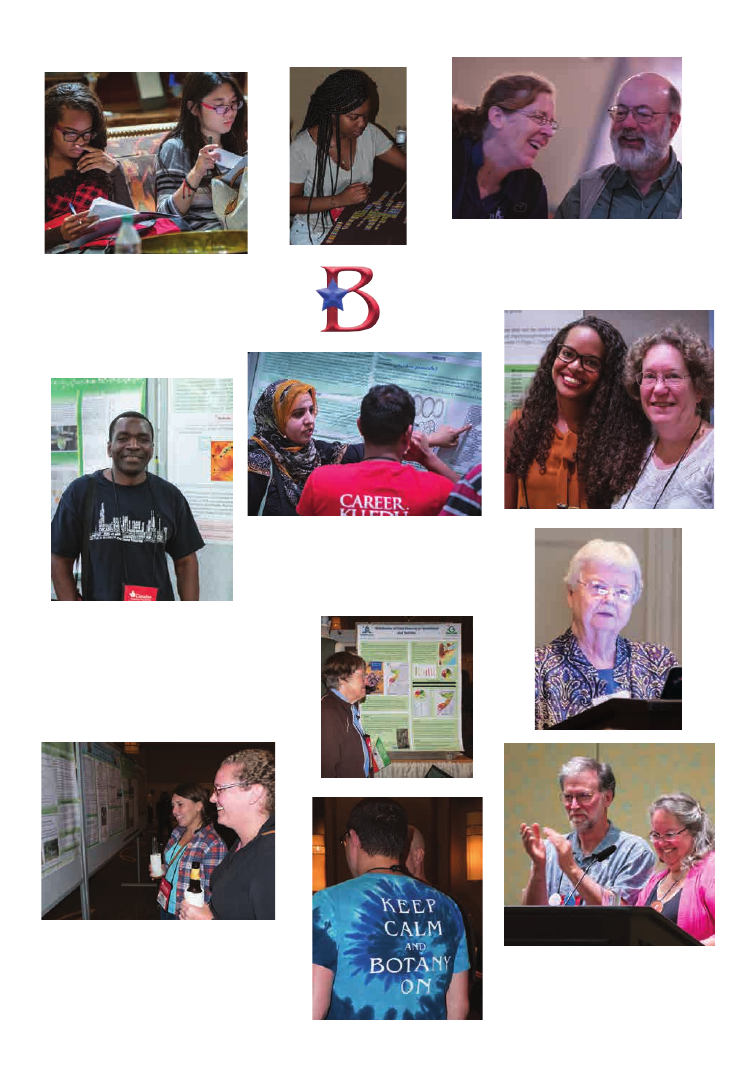
PSB 63 (3) 2017
133
Botany feels like
home
for a botanist.
Thank you for being so student
friendly. My undergraduates had a
great time.
I had not attended the pre-
vious botany meetings since
I live in Venezuela, it was a
very enriching experience!
I really enjoyed the opportunity to
hear more about current research
and interact with my colleagues.
I was going to go to ESA, but I
missed the abstract deadline. Boy,
am I glad I did, because Botany was
a great conference!
I would go to a Botany conference
wherever it is located because it
introduces me to new places I would've
never considered previously traveling to.

PSB 63 (3) 2017
134
Bring a New Experience
to Undergraduate Research
Introducing the LI-6800 Portable Photosynthesis System
Ask about our LI-COR
Environmental Education Fund (LEEF)
www.licor.com/6800-leef

PSB 63 (3) 2017
135
Hello! And welcome—make yourself com-
fortable. I’d like to talk with you today about
your Society journals.
I get that you read and publish papers, but
you’re not that interested in what happens in
an editorial office. I thought it would be really
great, though, if we could, on occasion, dis-
cuss a few items of possible mutual interest.
Today, let’s chat about those persistent, and
frequent (!), opportunities you receive in your
email Inbox to upload your published article
PDFs to third-party sites such as Research-
Gate and Academia.edu, sometimes referred
to as Scholarly Collaboration Networks, or
SCNs.
In 2012, an author I’ll call “Martin” contacted
the editorial office of AJB and wondered what
we, as editors and publishers of a Society jour-
nal, thought of these sites.
The question posed by Martin was: “Bad for
business, or a good way for people to access
more papers?”
He liked the article-level metrics these sites
provided. He liked sharing his work widely
and being discovered by other researchers. But
By Amy McPherson
Director of Publications,
BSA; Managing Editor,
American Journal of
Botany
ORCID id 0000-0001-
7904-242X
he was worried about whether he was violat-
ing copyright. And he wondered what impact
these sites might have on a Society publisher.
That was 5 years ago: SCNs have definitely
grown over that time, and they’re very pop-
ular. On the one hand, we (your Society pub-
lishers) want our authors’ work to be discov-
erable (and citable). Heck, we work with you
to promote your work on Twitter and Face-
book; we work with writers and press offices
on press releases; we encourage you to share
your work; we are about to increase our out-
reach through our partnership with Wiley. We
offer an Open Access option, all abstracts are
always freely available, and all articles are free-
ly available after one year. BSA members have
free access to AJB, do not pay page charges,
and receive discounts on OA charges (APCs).
On the other hand, your Society publisher is
not crazy to have readers directed away from
our site. When your PDFs are posted on an
SCN, they take readers away from the version
of record on our site, and with them, the us-
age data and article-level metrics. We’d like to
know, too, when your article is viewed, down-
loaded, shared, mentioned, etc., as would
the libraries who subscribe to AJB. Librari-
ans carefully review usage data to determine
whether or not to renew their subscription
(our lifeblood). Library budgets have been
tight and either declining or holding steady, at
best, for years; librarians have to make tough
decisions every year.
Journals and librarians do not get usage data
from Academia.edu or ResearchGate. Au-
thors get article-level metrics, but the data are
A chat about publishing: Scholarly
Collaboration Networks

PSB 63 (3) 2017
136
not standard (i.e., not COUNTER compliant).
These sites also don’t necessarily have the sup-
plemental data that was uploaded with the ar-
ticle, and they miss any addenda to the article
(corrections, retractions, etc.). And yes, you
might be violating the copyright or licensing
agreement.
When we’re asked, we suggest that authors in-
clude links to, not PDFs of, their articles—but
we know most people don’t ask, or even know
what they have the right to post.
For AJB, we allow posting of the accepted
manuscript, and sharing of the PDFs with
interested researchers, but we prefer that the
PDF be accessed on our site if possible, or
shared with individuals; we support the “Vol-
untary Principles for article sharing on schol-
arly collaboration networks” (see below).
We know it’s tough to figure out what’s con-
sidered permissible in this crazy day and age
of scholarly publishing. If you are unclear of
what’s allowed based on the agreements you
have signed with publishers, do not despair.
Check out http://www.howcanishareit.com/.
I think this concern over where the PDF of
your article is posted is temporary and will
be resolved in the not-too-distant future, be-
cause it is essentially a technical issue. And we
all know that technology moves constantly
and fast.
You are reading this in the Plant Science Bul-
letin, so you are taking advantage of a Soci-
ety publication. If you are a BSA member, I
assume that you are also interested in the
American Journal of Botany and Applications
in Plant Sciences—I hope you are. Like oth-
er Society journals, we are mission-driven: we
exist to support botany and our members (see
BSA mission in accompanying box). Some
Society journals are self-published, as we have
been for over 100 years; some partner with a
publisher, as we will begin doing in 2018
with Wiley (see the note elsewhere in this
issue of PSB).
We are honored to work with you, and we
look forward to continue doing so well into
the future. Go Botany!
That is all for now. If there is another pub-
lishing item you’d be interesting in chatting
about, please let me know.
Mission of the Botanical Soci-
ety of America: “[to] promote
botany, the field of basic sci-
ence dealing with the study
and inquiry into the form,
function, development, di-
versity, reproduction, evolu-
tion, and uses of plants and
their interactions within the
biosphere."
Additional Reading:
• To explain what COUNTER is: https://
www.projectcounter.org/
• Voluntary Principles: http://www.stm-as-
soc.org/2015_06_08_Voluntary_princi-
ples_for_article_sharing_on_scholarly_col-
laboration_networks.pdf
• What’s acceptable in sharing research arti-
cles: http://www.howcanishareit.com/
• After I wrote this essay, the following blog
post regarding copyright compliance ap-
peared on The Scholarly Kitchen. If you are
interested in the topic, you will no doubt be
interested in this and the comments that ac-
company the post: https://scholarlykitchen.
sspnet.org/2017/10/06/researchgate-publish-
ers-take-formal-steps-force-copyright-com-
pliance/?informz=1

PSB 63 (3) 2017
137
The 19th International Botanical Congress
was held at the Convention and Exhibition
Center in Shenzhen, China, from July 23 to
July 29, 2017. The nomenclatural session was
held the previous week, with 155 participants
from 30 countries/regions. There were many
noteworthy highlights for this Congress:
the first time it was held in China; a record
attendance of 7358 individuals from 110
countries/regions, with 6850 participants
from 77 countries/regions; and the first
awarding of the Shenzhen International
Award in Plant Sciences (to Peter H. Raven).
There were 1444 talks in symposia, distributed
over six themes:
• 243 in T1 – Biodiversity, Resources and
Conservation
• 462 in T2 – Taxonomy, Phylogenetics and
Evolution
• 180 in T3 – Ecology, Environments and
Global Change
• 254 in T4 – Development and Physiology
• 221 in T5 – Genetics, Genomics and Bioin-
formatics
• 84 in T6 – Plants and Society
By Andi Wolfe
Department of Evolu-
tion, Ecology, and Or-
ganismal Biology, The
Ohio State University
There were nearly 1000 posters on display, or
found on the electronic kiosks as e-Posters:
160 in T1, 332 in T2, 162 in T3, 140 in T4, 128
in T5, and 49 in T6. The number of simultane-
ous symposia, combined with the huge size of
the convention center, limited the opportunity
for popping in and out of sessions. However,
all the Plenary Lectures were conducted in the
largest venue of the convention center (Fig. 1),
without competition, and the Keynote Lectures
were also scheduled with minimal conflicts.
All-in-all, the scientific program was amazing,
and all of the abstracts and posters were avail-
able through an app. There were Wi-Fi connec-
tions throughout the convention center.
In addition to the stimulating symposia, lec-
tures, and posters, the Congress offered an
incredible program for the opening gala, the
Congress banquet, and the closing ceremony.
The performances for the opening gala includ-
ed ballet, Chinese opera, and acrobatics. Simi-
lar entertainment was offered for the banquet,
and a chamber orchestra provided music for
the closing ceremony. The Botan
ical
Society of
Figure 1. The main hall of the convention cen-
ter, before the opening ceremony.
Recap of the 2017 International
Botanical Congress

PSB 63 (3) 2017
138
America co-sponsored a reception to honor
this year’s corresponding member awardees.
Loren Rieseberg did the honors, and there
was quite a “who’s-who” in attendance.
The convention center was bedecked in the
Congress colors, posters, video screens, and
live plant sculptures (Fig. 2). The surrounding
skyscrapers provided nighttime light shows,
celebrating botany. There were several art ex-
hibits on botanical themes, and a couple on
conservation themes, including a huge display
that ran the length of the convention center,
and a sculptural display featuring live plants
from the unique biomes of China (Fig. 3).
Student volunteers were abundant and very
helpful to the linguistically challenged. Re-
freshment breaks (Figs. 4 and 5) presented a
challenge in foraging, with long lines and food
or beverages running out early, but that was
one of the few logistical problems presented by
a record-breaking attendance. There was also
an incredible trade show, which was adjacent
to the poster display area, electronic kiosks for
the e-posters, and the press room. Highlights
from each day of the Congress were published
in the daily newspaper, and members of BSA
were prominently featured.
The major theme of this Congress was conser-
vation and sustainability, which was reflected
in the Shenzhen declaration on plant sciences.
The call for action listed seven priorities:
1. To become responsible scientists and re-
search communities who pursue plant scienc-
es in the context of a changing world.
2. To enhance support for the plant sciences to
achieve global sustainability.
3. To cooperate and integrate across nations
and regions and to work together across disci-
plines and cultures to address common goals.
4. To build and use new technologies and big
data platforms to increase exploration and
understanding of nature
5. To accelerate the inventory of life on Earth
for the wise use of nature and the benefit of
humankind.
6. To value, document, and protect indige-
nous, traditional, and local knowledge about
plants and nature.
7. To engage the power of the public with the
power of plants through greater participation
and outreach, innovative education, and citi-
zen science.
The Shenzhen declaration was passed as
Resolution 4 during the closing ceremonies.
Figure 2. The main plaza at the Shenzhen
Convention and Exhibition Center, featuring
numerous plant sculpture displays.
Figure 3. The conservation walkway in the
convention center.

PSB 63 (3) 2017
139
Four additional resolutions passed, including
one from the nomenclatural session, one for
working actively for gender equity in the plant
sciences, one for fostering international coop-
eration between the International Association
for Plant Taxonomy and the Chinese botan-
ical community through establishment of an
IAPT-China office, and, finally, to establish
that the XX International Botanical Congress
will be held in Rio de Janeiro, Brazil, in 2023.
Major themes throughout the Congress were
the use of big data from all sort of “-omics,”
integrating information from various databas-
es for innovative data analyses, and a new ini-
Figure 4. The trade show and poster hall also served as a primary break area each day.
Figure 5. The upper floors of the convention center had two break areas for the morn-
ing and afternoon sessions. Beverages and snacks were served.
tiative for genomics: the 10KP project, where
10,000 plant genomes are to be sequenced.
The scale of this Congress was overwhelm-
ing—not only in the number of attendees,
presentations, posters, and sheer size of the
venue, but on the amount of new information
to assimilate, as well as the efforts put forth
by the Chinese botanical community, the city
of Shenzhen, and the Chinese government to
ensure a successful meeting. The bar for inter-
national botanical meetings has been raised to
a new level. The next Congress will be the first
to meet in South America, so there is a lot to
look forward to. See you in Rio!
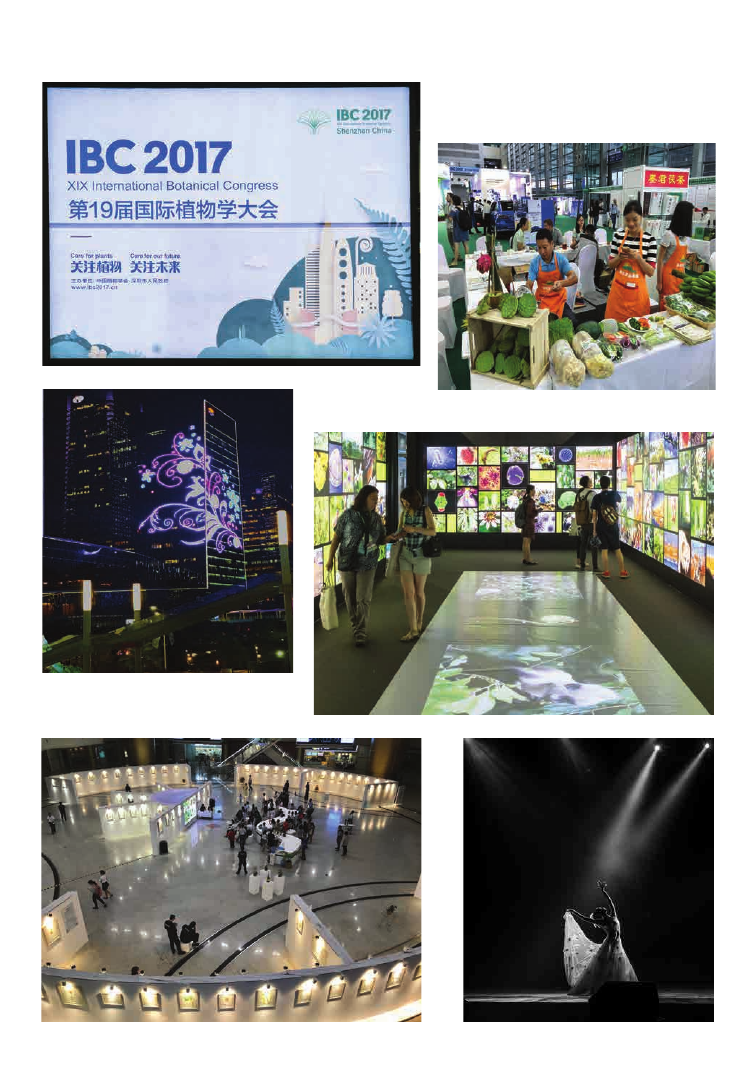
PSB 63 (3) 2017
140
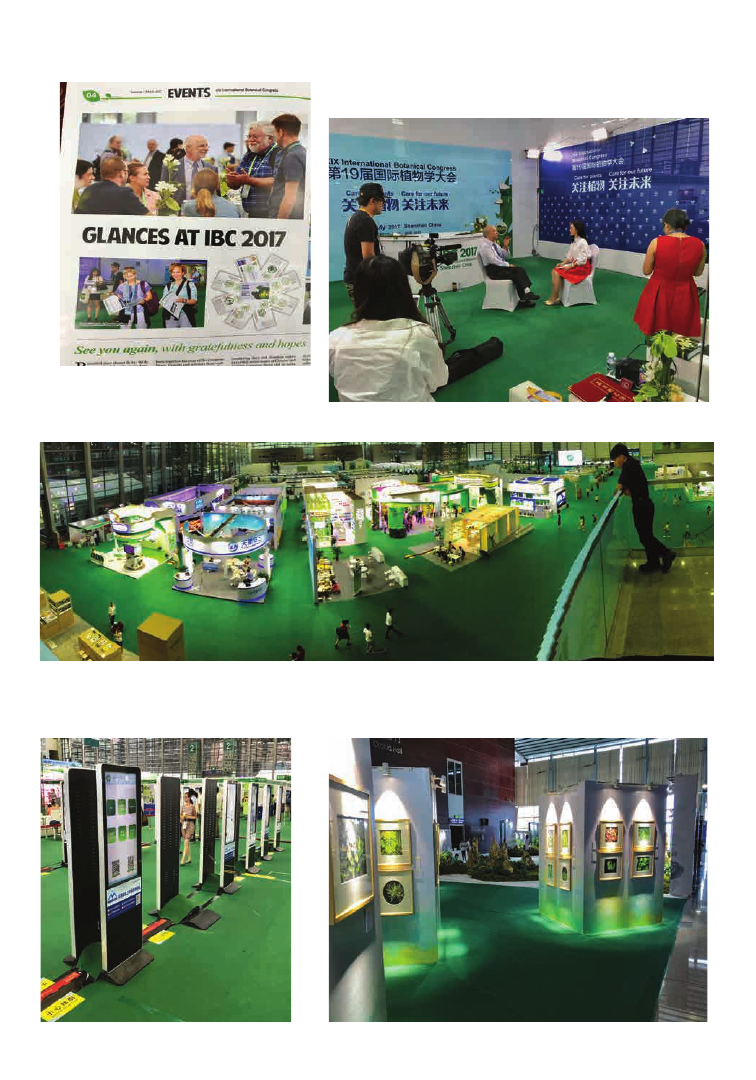
PSB 63 (3) 2017
141

PSB 63 (3) 2017
142
By Harry T. (Jack)
Horner
Chair, BSA Investment
Committee
The compound question in the title needs
to be asked of every member of our Society,
emeritus members, distinguished fellows,
BSA Officers, committee and section chairs
and members, regular members, and stu-
dents. A little over two years ago, I wrote an
article for PSB titled “Where Goes the BSA
Endowment: A Legacy Yet to the Written”
(2015 61[2]: 62-63). As continuing chair of
the Investment Committee whose task it is to
co-manage, along with an outside investment
firm, the endowment funds for growth and
use for Society initiatives, I have become in-
creasingly aware that the BSA membership, as
a whole, needs to understand the importance
of financially giving to the endowment, as it
is able.
What does this actually mean? BSA has grown
in stature and importance to the entire botan-
ical community worldwide since its inception
in 1893, about 124 years ago (http://cms.bot-
any.org/home/about/an-historical-overview-
of-the-bsa.html). During this entire period,
botany has expanded into new fields, has giv-
en birth to new plant societies, and yet has
retained its breadth as a basic plant biology
What Does the Botanical Society
of America Do for You and What
Do You Do for the Society?
society. BSA has developed important pub-
lications, and programs in education, tech-
nology, and research and travel grants that
serve a broad spectrum from young people
to seasoned researchers. Together, these latter
groups represent the heart of botany and inev-
itably its future.
In order to maintain BSA’s vital role in the
field of botany, and its nurturing and devel-
opment of future botanists, we the members
in all membership categories, must make a
continued financial commitment, no matter
how small or how large, to helping the BSA
Endowment grow from its present $5M to
+$10M, so it can become a beacon of financial
support for all of the Society’s initiatives and
programs, well into the future.
Please consider giving $5, $10, $50, $100,
$500, $1000 or more annually (or right now) as
you are able, through a check or other means
to: The BSA Endowment Fund, Business Of-
fice: 4475 Castleman Avenue, St. Louis, MO
63110-3201. Let this be your commitment to
the Society and those who follow.
To paraphrase a past President of the United
States who understood what commitment was
all about, “It’s not what the Society can do for
you but what you can do for the Society.”

PSB 63 (3) 2017
143
Latest News on the
PLANTS Grant Program
The PLANTS grant program (Preparing
Leaders and Nurturing Tomorrow’s Scientists:
Increasing the diversity of plant scientists) has
just finished its seventh year. Currently man-
aged by co-PIs Ann Sakai (UC-Irvine), Anna
Monfils (Central Michigan University), and
BSA Staff Member Heather Cacanindin, the
goal of the PLANTS program is to encour-
age students from under-represented popula-
tions to become part of the scientific botanical
community and, in particular, to help them
understand the opportunities possible with
an advanced degree and to learn about careers
in the plant sciences. The program, which is
funded by the National Science Foundation
with additional support from BSA, brings 10
to 14 students, who are chosen through an
open application process, each year to the an-
nual BOTANY conference. The review com-
mittee for the applications includes members
of the BSA Human Diversity Committee and
two former PLANTS Scholars.
PLANTS students attend scientific talks with
mentors, a workshop on applying to graduate
school, the Human Diversity Luncheon, and
numerous social and networking events. With
assistance from Dr. Sakai, Dr. Monfils, and Dr.
Ann Hirsch, as well as all those who served
on the PLANTS grant selection committee, 72
students were funded over the first six years of
the PLANTS grant (2011-2016). In 2017, 13
students were selected to attend the Botany
2017 Conference in Fort Worth, Texas.
At the core of the program are the mentors
who serve to guide the students through what
to expect at a scientific conference of this mag-
nitude. Each student is assigned a peer and a
senior mentor. Mentors were matched to stu-
dents based on student requests for particular
research areas. A new addition to the program
this year was a pre-meeting webinar hosted by
the PIs and BSA staff to acquaint students and
mentors with meeting opportunities, logistics,
and responsibilities.
Mentors contact students before the meeting,
attend social activities and scientific talks with
the students, help the students network with
other students and faculty at the meeting, and
in general, introduce students to the broader
relevance and application of the discipline.
Mentors pass on to the students the genuine
intellectual excitement and involvement of
the conference participants. In fact, many
mentors maintain contact with their mentees
after the conference is over, providing insight
and guidance on their career path and assist-
ing them with graduate school and grant ap-
plications.
Our mentors are committed to helping young
scientists and increasing the diversity of plant
scientists. Mentors hail from government
positions, small colleges, large research in-
stitutions, and nonprofit organizations. They
represent the variety of job opportunities in
the botanical sciences. Almost 100 mentors
have participated in the program since 2011.
They enthusiastically share their personal ex-
periences and expertise in the sciences and
serve without compensation or reimburse-
ment. The mentors are truly the backbone of
the PLANTS program and provide impactful
experiences for the PLANTS students. The
networking and mentoring both proved to

PSB 63 (3) 2017
144
be highlights for the students as they helped
to create a “sense of community” and a place
where the students felt supported. One 2017
PLANTS recipients recently stated, “I was so
humbled by how kind, supportive, and helpful
my mentors were.” Another reiterated the im-
portance of the sense of community created
by the PLANTS program: “The program has
given me a community that I was lacking and
has tremendously increased my confidence as
a student.”
The PLANTS grant co-PIs keep in touch with
the past PLANTS scholars and track their
progress and careers. So how is the PLANTS
II program impacting careers? For our 2016
PLANTS cohort of scholars, one student is
currently in a PhD program and has received
a Ford Foundation Fellowship, three students
are in Masters programs, one student is study-
ing at an Environmental Science Institute, and
two students are working in the plant scienc-
es at botanical gardens/herbaria and plan to
apply to graduate school this fall. This means
that 82% of the 2016 PLANTS scholars are
still pursuing careers in the botanical sciences.
The success, enthusiasm, and contributions
of the PLANTS participants have helped to
make our botanical community more aware
and proactive about encouraging the diver-
sity of plant scientists within the Society and
the plant sciences as a whole. We continue to
have increased recognition and support of
the program from members of the Society,
as PLANTS I program alumni are active and
are recognized within our scientific commu-
nity. In fact, two past PLANTS scholars have
been elected student representatives to the
BSA Board (James McDaniel [UW-Madison]
and Chelsea Pretz [UC-Boulder]), and sev-
eral have been recognized with Best Student
Paper awards by their sections as well as BSA
research awards. Moreover, a transformation
of the membership of the BSA has begun to
occur as documented by the increase in the
diversity of our overall membership. From
2011 to 2017, representation of BSA members
who were American Indian/Alaska natives,
Pacific Islanders, and African American/
Black together rose from <1% to 2.7%, and
members who were Hispanic or Latino/a rose
from 2.3% to 4.6% of the U.S. membership, for
a total of 7.3% of U.S. members.
Science will not thrive unless it is equally ac-
cessible to students from all backgrounds, in-
cluding those from groups that are currently
underrepresented. Access involves knowl-
edge about the discipline, understanding
the culture of science, feeling welcome as a
participant in scientific endeavors and as a
member of the scientific community, and un-
derstanding job opportunities in the area. The
PLANTS program continues to be successful
in encouraging students from underrepre-
sented backgrounds to become part of our
scientific community. The PLANTS program
is just one part of an overall growing effort by
the Society to provide a range of profession-
al development opportunities to our student
members. Some of these efforts include host-
ing non-academic career panels, workshops
and symposia about science communication
and dissemination, broader impacts issues,
and career speed-dating.
When the call for applications comes out in
February for the PLANTS Award, please care-
fully consider those who you might encour-
age to apply for this opportunity. In May, we
will again be seeking peer and senior mentors
for the 2018 cohort of PLANTS Scholars. If
you are planning to attend BOTANY 2018
in Rochester, this could be a fantastic way for
you to make new connections and positively
impact the life of an aspiring plant scientist.
If you have any questions about the program,
please feel free to contact the BSA Office or go
to https://cms.botany.org/home/awards/trav-
el-awards-for-students/plants-grants.html.

PSB 63 (3) 2017
145
After 15 years of serving as the BSA’s executive
director, Bill Dahl retired from his position on
October 1, 2017. He’s affected the lives of count-
less BSA members and leaves behind a spirit in
the Society that will continue for many years.
The PSB is pleased to present a final discussion
with Dahl just before his departure. We wish all
the best to Bill, his wife Janice, on future days
filled with travel and photography!
What drew you to the position of Executive
Director of the Botanical Society of America?
It’s actually a love story. I was having a won-
derful life in New Zealand in a similar position
with New Zealand’s largest community health
provider. New Zealand has the “dreaded” na-
tional health system and they actually take
care of people with mental health issues! We
assisted the most severe in a transition from
hospitalization back into community living. A
fantastic system focusing on health—but that
gets away from the question!
I came to the USA in 2000 to visit a U.S. part-
ner and ended up at the conference of the
American Society of Association Executives.
My boss Gerry was attending and he invit-
ed me along. He felt we’d have a week to talk
strategy.
On the first morning I attended a session called
a CEO Boot Camp. I walked into a room with
about 600 people, started one way, stopped,
turned around and found a seat right next to
Janice Grauberger (now Dahl). From there we had
some amazing discussions and a very nice few days.
I did see Gerry a few times in passing (LOL).
Two years later, our kids (from previous mar-
riages) had all graduated and left the nests,
and we were in a race to find employment in
each other’s countries. Jan’s connections put
her onto the BSA’s search for an Executive Di-
rector. I applied and had the pleasure of meet-
ing with Judy Jernstedt and Ed Schneider in
the Los Angeles airport. Months later I came
to the BSA meeting in Madison for another
interview and had the pleasure of meeting
with the Board. It was also my introduction
to Johanne Stogran and her family, who were
running the Botany conferences. By October I
was in St. Louis working for you.
What were your first impressions of the BSA
and/or botanists in general?
It was nice to see and feel how important the
long-term health of the BSA was to most of
the Board and Society members. In conjunc-
tion with that, how dedicated people were to
An “Exit Interview” with Retiring
BSA Executive Director, Bill Dahl

PSB 63 (3) 2017
146
plants and everything about plants and mak-
ing sure others had the opportunity to share
in their discoveries. I’ve been extremely fortu-
nate to be involved with this group and have
learned so much about so many things.
What’s the biggest challenge that you felt
you faced as Executive Director of the BSA?
Hmm, there were so many exciting things. I
guess the first was landing in St. Louis to the
large space allocated to the BSA at the Mis-
souri Botanical Garden. There was a desk
and a phone—that was it. From there it was
building a team and setting the foundation in
an effort to focus on the BSA’s mission. The
Board provided me/us with the document
titled “BSA Strategic Planning/Action Plan:
Deep Thought,” which set the foundation for
the next six to seven years of work. It was a
fantastic map forward.
The first thing I did was ask Wanda Lovan to
join the team. Her ability to remember people,
events, and everything else we were involved
in has always been a tremendous asset for the
Society. She’s also the glue that pulls every-
thing together.
What are you proudest of?
First would be the team that was pulled to-
gether to support the Society’s mission. They
have and will continue to make anything pos-
sible.
I’d love to be able to say my biggest achieve-
ment was the growth and development of the
Botany Conference program—but that was
Johanne Stogran working with various BSA/
ASPT/ABLS and AFS meeting directors. Or
that it was the development of our publica-
tions, the American Journal of Botany, Appli-
cations in Plant Sciences, and the Plant Sci-
ence Bulletin, and the support given to their
authors—but that was Amy McPherson, Beth
Parada, and Richard Hund working with the
editors and editorial boards. Or that it was our
response to educational needs and the devel-
opment of the PlantingScience program—but
that was initially Claire Hemingway, followed
by the amazing work Catrina Adams and Jodi
Creasap-Gee are doing now along with var-
ious education directors and so many ded-
icated members and Society partners. And
the growth in the membership, in particular
younger members and building the platform
for them to become involved in steering the
future direction of the Society—but, again,
that was someone else: Heather Cacanindin.
Of course, all of this involved developing
technologies and web-based support led by
Rob Brandt.
And the Boards and Board members—what
a treat! I’ve had the pleasure of working with
a wide range of botanists. Just the Presidents
alone—Judy Jernstedt, Scott Russell, Lin-
da Graham, Allison Snow, Ed Schneider,
Chris Haufler, Pam Soltis, Karl Niklas, Kent
Holsinger, Judy Skog, Steve Weller, Elizabeth
Kellogg, Pam Diggle, Tom Ranker, Dick Ol-
mstead, Gordon Uno and Loren Rieseberg—
wow! And that’s just a small part of the entire
group of Board members. And then there are
folks like the current PSB editor, Mackenzie
Bill Dahl in the early days of his time at the
BSA, along with Administrations Officer
Wanda Lovan.

PSB 63 (3) 2017
147
Taylor, who was the first BSA student repre-
sentative on the Board (and the 10 or so that
have followed her). It makes me smile.
So you see, it’s always been the team! We are
botanical.
The PlantingScience program is a major high-
light. In Mobile, in 2003 Dr. Bruce Alberts
challenged us to get off our backsides to sup-
port science education in a meaningful way. I
feel we continue to do so; there are very few
ventures of this type bringing scientific soci-
eties together to support the understanding of
science. In concert, we support middle- and
high-school teachers while mentoring their
students in the core principles of scientific in-
vestigation. Dollar for dollar, this program has
more potential to get young people involved
with plants, science, and scientists than any-
thing else out there.
What changes, positive or negative, have
you seen in the Society, or in scientific soci-
eties in general, during your time as Execu-
tive Director?
Slowly but surely, collaboration is becoming
important across scientific societies. Biology
is so diverse that it creates a real communica-
tions problem. AIBS made a good move in fo-
cusing on legislative issues because someone
needs to speak for biology, and the mix of so-
cieties makes it very difficult. I hope this con-
tinues and that folks find new ways to work
together.
I’d also like to stress how the efforts of a few
make a huge, really huge, difference for the
whole. Diversification is an important direc-
tion in science as our demographics shift.
I remember back as far as 2003 when BSA
members Karen Renzaglia and Jeff Osborn
put together the Undergraduate Mentoring
in Evolutionary Biology (UMEB) program to
support under-represented peoples in coming
to our meetings. Later after the UMEB pro-
gram expired, Ann Sakai and Ann Hersch,
supported by then-BSA President Judy Skog
and Heather Cacanindin, evolved this concept
into the BSA PLANTS program. I smile with
the knowledge that two of the current BSA
Board members are past PLANTS recipients.
What do you think will be the biggest chal-
lenge for the Society in the next 10 years?
Filling the understanding gap as to why it is
important to support scientific societies and
society-based publishing. The BSA has done a
very good job in supporting member-publish-
ing options in the American Journal of Botany,
Applications in Plant Science, and Plant Sci-
ence Bulletin, yet we continue to hear young
scientists looking to publish in other places
without understanding why.
Do you have any parting words of wisdom?
Cherish the importance of plants, and what
you and what your peers do as botanists!
From ecosystem down to the tiny bits of DNA,
plants are critical to all life as we know it.
What’s Next Regarding the
BSA Executive Director
Position?
With Bill’s retirement, Heather
Cacanindin has been named as
the Interim Executive Director.
A search committee has been
formed, and its members will
be reviewing applications for
the Executive Director position.
The position should be filled in
early 2018.

PSB 63 (3) 2017
148
After careful consideration and deliberation
over the past year and a half regarding the fu-
ture of its publishing program, the BSA has
decided to enter a publishing partnership
with John Wiley and Sons, beginning official-
ly in January 2018. This agreement will affect
the Society’s two research journals, American
Journal of Botany and Applications in Plant
Sciences. Both titles will be hosted on Wiley
Online Library, including back file content
from AJB dating back to 1914.
“The Botanical Society of America looks for-
ward to this partnership with Wiley,” said BSA
President, Dr. Loren Rieseberg. “Wiley’s prov-
en expertise in scientific publishing and mar-
keting will not only expand the reach of BSA
publications, but also provide enhanced tools
and technologies to assist our authors and
members with the publication process and the
dissemination of their research.”
“Wiley is proud to be selected as BSA’s pub-
lishing partner,” said Colette E. Bean, Vice
President & Society Publishing Director for
the US, Wiley. “The BSA is a leader in plant
science research, and we are honored to part-
ner with them to publish their prestigious
journals. We very much look forward to
working with the BSA to continue to publish
high-quality content that supports their com-
munity of authors, readers, and members, and
to further advance the knowledge and com-
munication of botanical research.”
What does this mean for readers and authors
of the journals? First of all, editorial control of
the journals remains with the editors-in-chief
(Drs. Pamela Diggle for AJB and Theresa Cul-
ley for APPS). BSA staff members for each
journal (Amy McPherson and Richard Hund
for AJB and Beth Parada for APPS) will also
remain to serve authors, reviewers, and edi-
tors throughout the publication process. The
article submission system authors have used
for years, Editorial Manager, will be retained.
The most visible change will be the online
hosting of each journal via the Wiley Online
Library. The new websites will offer an up-
dated look for each journal and better author
tools. With Wiley, the BSA is looking to ex-
pand the journals’ reach; modernize the on-
line presence; support our authors, reviewers,
editors, members, and subscribers; and keep
current with the demands and challenges of
scientific publishing in the 21st century.
With changes to come, one thing above all will
remain the same: the mission of the Society
to promote botany. If you have any questions,
please contact us at ajb@botany.org.
BSA Enters Publishing Partnership
with John Wiley and Sons

149
I
n a poster designed by cartoonist Walt Kel-
ley to publicize the first annual Earth Day
in 1970, Pogo the Possum is shown picking
up trash that humans have strewn across his
home in Okefenokee Swamp, with the head-
line, “We have met the enemy and he is us.”
This quote has even greater resonance today.
Humans are the main threat to life on our
planet and have emerged as its dominant se-
lective force. While climate change receives
the most publicity, it isn’t the only concern.
Other threats include habitat destruction, ur-
banization, and the spread of pests and dis-
eases. In a human-altered world, plants must
adapt to these changes, migrate to a new en-
vironment, or die. I devoted my presidential
address to discussing the importance of one
of these responses to anthropogenic change:
evolutionary adaptation. I specifically asked
the following questions: How fast can plants
evolve? How fast do they need to evolve to
Plant Evolution in a
Human-Altered World
By Loren H. Rieseberg,
BSA President
University of
British Columbia
cope with climate change? How can we aid or
hinder adaptation? And, how can we convert
this knowledge into action?
How fast can plants evolve?
Despite the focus of evolutionary biologists on
adaptation for over 150 years, an answer to this
question remains out of our reach. Nonetheless,
theoretical and empirical studies allow us
to draw some preliminary conclusions. In
an influential theoretical study of rates of
adaptive phenotypic evolution, Bürger and
Lynch (1995) employed a simulation model
in which selection acts on a quantitative trait
that is correlated with fitness. They reported
that in a large population, the sustainable rate
of phenotypic evolution is “a few percent”
of a phenotypic standard deviation (SD)
per generation. In small populations, the
sustainable rate of evolution was even lower:
<1% of a phenotypic standard deviation per
generation. Recent theoretical studies support
these general conclusions (e.g., Kopp and
Matuszewski, 2013).
Why is evolution so slow, at least according
to theory? One potential impediment to
adaptation is the depletion of beneficial
SPECIAL FEATURE
Remarks from Botany 2017 by President Loren Rieseberg

PSB 63 (3) 2017
150
genetic variation. The rate of adaptation is
also limited by the number of selective deaths
that have to occur to replace one allele with
another. This is referred to as the “cost of
selection” (Haldane, 1957) and can lead to
population extinction if selection is too strong.
Conversely, phenotypic plasticity and density-
dependent or “soft” selection provide a buffer
against extinction. That is, if the strength of
selection is commonly reduced at low densities
(e.g., due to a reduction in the intensity of
competition or spread of a disease), extinction
risk might be much lower than predicted by
conventional “hard selection” models.
What can we learn from empirical studies?
Evolutionary biologists typically quantify
rates of contemporary phenotypic evolution
in terms of Haldanes, where a Haldane is
defined as a change of one phenotypic SD
per generation. I searched the literature for
studies that had estimated rates of phenotypic
evolution in plants, building on a review
by Bone and Ferris (2001). I only included
studies that reported on rates of phenotypic
evolution in natural populations and verified
through common garden or reciprocal
transplant studies that the phenotypic
changes were genetically based rather than
plastic. Results indicate that while rates of
evolution can be very fast over the short
term, over longer time periods, phenotypic
evolution slows and is roughly consistent with
theoretical predictions (Figure 1). The decline
in rates over time likely has multiple causes,
including fluctuating selection pressures, the
approach to a new phenotypic optimum, and
the depletion of genetic diversity.
●
●
●
●
●
●
●
●
●
●
●
●
●
●
●
●
●
●
●
●
●
●
●
●
●
●
●
●
●
●
●
●
●
●
●
●
●
●
●
●
●
●
●
●
●
●
●
●
●
●
●
●
●
●
●
●
●
●
●
●
●
●
●
●
●
●
●
●
●
●
●
●
●
●
●
●
●
●
●
●
●
●
0.0
0.2
0.4
0.6
0.8
0
25
50
75
100
125
Generations
Haldanes
Rates of Phenotypic Evolution
Figure 1. Rates of phenotypic evolution in plants.

PSB 63 (3) 2017
151
How fast do plants need to
evolve to cope with climate
change?
To estimate the extent of phenotypic change
required to cope with climate change, I
surveyed the literature for studies that report
on phenotypic differences along latitudinal or
altitudinal clines. A rate of 0.45°C/degree of
latitude (Lindzen, 1994) and 0.5°C/100 m of
altitude (Marshal et al., 2007) was employed
to estimate temperature differences between
study sites unless more accurate values were
provided by the study. As before, only studies
that distinguished between genetic and plastic
differences were included in the analysis.
While there was considerable variation among
traits, phenotype differentiation averaged ~0.3
SD per degree of Celsius, which provides a
crude estimate of the magnitude of phenotypic
change necessary for adaptation to predicted
climate change.
Climate projections suggest temperatures will
rise between 2
o
and 5
o
C over the next century
(Raftery et al., 2017). Based on average
phenotypic differences observed along
altitudinal and latitudinal clines (above), we
can extrapolate that, on average, phenotypic
change of 0.6 to 1.5 phenotypic SDs per
century will be required to adapt to predicted
temperature changes, and in the absence
of migration. Assuming an average rate of
phenotypic evolution of 0.11 Haldanes, which
seems reasonable at least in the short term,
this implies that species with short to medium
generation times (8 years or less) might be
able to evolve rapidly enough to cope with
climate change (Figure 2). Species with longer
generation times must migrate.
Of course, this is a very rough approximation
and does not take phenotypic plasticity into
account. Also, there is likely to be considerable
variation among traits, populations, and
species in their response to selection. It
might be, for example, that traits more closely
associated with fitness will evolve more slowly
due to reduced genetic variation or genetic
and physiological constraints. In addition,
populations facing climate change may be
subject to other potential conflicting selection
pressures such as competition from invasive
species, new diseases, loss of pollinators,
habitat disturbance, and so forth that will slow
evolutionary responses to climate change.
Thus, it is important to compare these results
with other studies that examine threats to
plant species.
First, it is important to keep in mind that
presently climate factors are not a leading
11
Phenotypic SDs
0
1
5
4
3
2
0.6
1.5
Generation time (years)
1 2 4 8 16 32
=
Figure 2. Maximum expected phenotypic ad-
aptation over the next century compared to
necessary adaptation predicted by climate
models.

PSB 63 (3) 2017
152
threat to plant species. Kew Garden’s State
of the World’s Plants (2016) quantifies the
threatening processes for vascular plants
on the IUCN Red List. Agriculture (31%),
Biological Resource Use (21%), Urbanization
(13%), Natural System Modifications (9%),
and Invasives and New Pests and Diseases
(8%) are the main threats. Climate change and
severe weather are considered to be threatening
factors in <4% of species, but this number
is expected to grow in the future. A meta-
analysis of 131 studies across a broader array
of organismal groups (Urban, 2015) suggests
that climate change is a somewhat greater
threat (7.9% of species and accelerating) than
implied by the Kew report, but currently still
less than other major threatening processes.
On the other hand, a recent study of extinction
at the population level across the geographic
ranges of numerous plant and animal species
reported that local population extinctions at
the warm edge of species’ ranges are frequent
(Wiens, 2016). In plants, for example, roughly
40% of 260 plant species surveyed suffer from
warm edge extinctions. This implies that,
contrary to my calculations, populations of
many species are unable to cope with climate
change. Perhaps adaption at range edges is
frequently limited by maladaptive gene flow,
insufficient genetic variation, or conflicting
selection pressures.
Lastly, it is important to remember that
evolutionary adaptation is only one of several
biological processes that impact organismal
responses to environmental change. Other
key processes not considered here include
migration, species interactions, demography,
physiology, phenotypic plasticity, phylogenetic
constraints, and characteristics of the
environment. Ideally, models should include
information about all of these processes to
predict climate change responses (e.g., Urban
et al., 2016).
How can we aid or hinder
adaptation?
Understanding the factors that limit
adaptation is central to understanding how
evolutionary change can be facilitated when
desired (e.g., adapting to climate change) and
hindered when necessary (e.g., slowing the
evolution of pests and weeds). Population size
is probably most critical, as a large population
brings both genetic and demographic benefits
(Figure 3). Probably less widely appreciated
is the need to reduce conflicting selection
pressures brought about by the wide array of
threatening processes described above. Lastly,
it is important to manage levels of gene flow.
Gene flow can be beneficial by increasing
the genetic variation available for selection.
However, gene flow can be potentially
maladaptive as well by reducing the efficiency
of selection. The latter is most likely if levels
of gene flow are high and/or the gene flow
derives from genetically or ecologically
divergent source populations.
In terms of specific actions, one of the
most widely debated approaches is assisted
migration or assisted colonization (Ricciardi
and Simberloff, 2009; Aitken and Whitlock,
2013). As implied by the name, the method
refers to the translocation of genotypes to
a more suitable environment or one that
is predicted to be more suitable in the
future. Assisted migration includes assisted
population migration, assisted range
migration, and assisted species migration.
Assisted population migration, in which
genotypes are better matched with the
environment within the current range of

PSB 63 (3) 2017
153
a species, is least controversial and has
the potential to rescue species that cannot
migrate sufficiently fast or lack the capacity to
adapt in situ (Vitt et al., 2009). Assisted range
migration and assisted species migration are
more controversial because populations are
translocated beyond current range boundaries,
leading to legitimate concerns about potential
harm to recipient communities (Ricciardi
and Simberloff, 2009). With that said, given
ongoing and predicted anthropogenic
impacts, inaction may result in greater damage
to biodiversity than the careful integration
of assisted migration (broadly defined) into
conservation strategies (Schwartz et al., 2009).
In addition to adaptation of natural
populations, more attention needs to be given
to adaptation of managed populations, such
as fiber, forage, and food crops. This is critical
because agriculture and biological resource
use (e.g., logging) are currently the greatest
threats to plant diversity. With an expanding
human population, and dietary shifts due to
increasing affluence, competition for land and
water is expected to further intensify in the
future. Thus, we must not only increase the
productivity of our crop, forest, and rangelands
(thereby sparing land for conservation), but
also modify our agricultural practices to make
them more biodiversity friendly (Kremen,
2015). Practices that enhance local adaptation
of crops and trees can contribute to both
goals. For example, Wang et al. (2006) has
shown that implementation of a knowledge-
based policy in which seeds are matched
to future local climate can increase forest
productivity by circa 35% relative to the status
quo. Likewise, the breeding and deployment
of locally adapted crops has the potential to
both increase yields and reduce the need for
external inputs such as water and fertilizer.
• Large popula+ons: ⇑ beneficial muta-ons
• Strong selec-on: ⇑ ini-al rate of adapta-on
• Constant selec-on
Speed of adapta-on
• Small Popula+ons: ⇓ beneficial muta-ons, dri9, inbreeding
depression
• Fluctua-ng selec-on
• Low trait heritability
• Mul+ple Conflic+ng Selec+on Pressures
• Gene flow: increases variability, but reduces efficiency of
selec-on
• Gene-c correla-ons
Figure 3. Factors that affect rates of adaptation.

PSB 63 (3) 2017
154
To accomplish this, we must tap the genetic
diversity of environmentally resilient wild
plants, which has been shaped by millions
of years of natural selection. While in some
cases (e.g., crop wild relatives) this can be
accomplished via conventional breeding,
given the urgency of reducing agriculture’s
footprint, we should embrace and utilize the
full arsenal of agricultural biotechnology.
Modern plant breeding practices have
developed crop varieties that perform
exceptionally well in monoculture and soils
enriched by synthetic mineral fertilizers
(N-P-K). However, these varieties typically
are less well-suited to more sustainable
agro-ecological farming practices such as
intercropping, perennial systems, organic
matter inputs to soil, etc., which increase crop
and non-crop diversity (Kremen et al., 2012).
We need to re-orient breeding efforts toward
the development of cultivars that are locally
adapted, environmental resilient, and well
suited to agro-ecological farming practices.
Such well-adapted varieties will be required if
sustainable and diversity-focused agriculture
is to match the productivity of conventional
farming.
Methods for hindering adaptation in pests
or weeds are important as well and can
be viewed as the flipside of encouraging
adaptation. A general strategy therefore is
to limit population sizes of the pest, as well
as to reduce the consistency and strength
of selection pressure from the focal control
agent. For example, to reduce the evolution
of herbicide resistance, standard management
procedures
(e.g., http://hracglobal.com/
prevention-management/best-management-
practices) inc
lude: (1) crop rotations, which
permit the rotation of herbicides that vary in
mode of action; (2) cultural control methods
(e.g., plowing, delayed planting, mulching,
etc.) that release the weed population from
herbicide pressures and reduce the soil
seed bank; and (3) herbicide mixtures or
sequential treatments of different herbicides.
Unfortunately, except when enforced by
strict regulatory regimes, the implementation
of evolutionarily informed management
strategies tends to be haphazard and resistance
evolution is inevitable.
In the future, new biotechnology approaches
may be employed to both aid and hinder
adaptation of natural populations. One of the
most promising of these is gene drive, in which
inheritance is biased toward a particular copy
of a gene. As a consequence, a “drive” allele
will spread much more quickly through a
population than a mutation governed by
conventional rules of inheritance. New gene
editing methods make it possible to build
robust gene drive systems that could, for
example, eliminate populations of invasive
species, pests, and weeds by driving in
sterility or sex ratio bias genes. Alternatively,
it might be feasible to drive in genes that
protect species at risk due to climate change
or reduce pest damage. Of course, there are
many risks associated with deployment of
drive systems. For example, drive alleles
might have unintended consequences due
to pleiotropic or epistatic effects. They also
may spread beyond the target species if it
has sexually compatible relatives, potentially
wreaking havoc in non-target species. Most
likely, though, natural resistance will arise
to the drive allele, so that it will be stopped
long before it can move across the range of a
system. The bottom line is that there is much
more that we need to understand before
drive alleles should be released into natural
populations.

PSB 63 (3) 2017
155
How can we convert this
knowledge into action?
A popular cartoon shows a group of scientists
sitting around a conference table with the
caption, “The latest research shows that
we really need to do something with all of
this research.” Scientists have historically
been strong proponents of curiosity-driven
research, in which they choose both the
question to be studied and the experimental
program. Results contribute to our basic
understanding of how the world works and
typically do not have an obvious application.
However, such research sometimes leads
to serendipitous breakthroughs. It also is
important to keep in mind that all applied
research builds on this foundational research.
The curiosity-driven research paradigm has
been extraordinarily successful and is arguably
mainly responsible for the extraordinary
pace of scientific discovery and technological
innovation seen over the past century. The
one potential weakness is that the knowledge
flow is unidirectional (from scientists to end-
users). This has sometimes been likened to a
loading dock. Scientists dump the information
on the loading dock, but most of the time no
one picks it up.
An alternative solution-driven paradigm
has been building steam of late, driven by
the desire of funders (mainly governments)
to extract greater economic benefits from
the science they fund. In this paradigm,
research is focused on finding solutions for
end-users, whether they are in government,
industry, NGOs, or society, more generally.
Knowledge is produced jointly and the flow
of knowledge is bidirectional, with benefits to
both researchers and end-users. Results tend
to be more specific and applicable to end-user
concerns. The downside is that such research
is less likely to contribute importantly to
our broader understanding of the natural
or physical world, and fundamental
breakthroughs are less likely.
I spent my first two decades in academia
focusing solely on curiosity-driven research
(and loving every minute of it). However,
given the severity of the challenges facing
the globe, I believe that there is a need for
both curiosity- and solution-driven research.
Thus, I urge botanists to engage with end-
users, such as land managers, farmers, plant
breeders, policymakers, etc. to learn their
concerns and co-design research programs
that may contribute to solutions. My own lab’s
efforts are now split approximately equally
between these two endeavors. I do miss the
heady days of doing whatever I wanted all of
the time, but my lab’s research program over
the past decade has been greatly enriched by
engagement with end-users.
While conducting research is important,
most of us will have a greater impact through
education. My own accomplishments pale
in comparison to those of my students. For
example, my first two students, Dulcé Arias
and Oscar Dorado, were both from the state
of Morelos, Mexico. After leaving my lab, they
returned to Morelos, where they established
the world’s largest tropical deciduous forest
preserve, the Huatla Sierra Biosphere Reserve
(http://www.unesco.org/new/en/natural-
sciences/environment/ecological-sciences/
biosphere-reserves/latin-america-and-
the-caribbean/mexico/sierra-de-huautla/).
Tropical deciduous forest is one of the
world’s most threatened habitats, and the
Huatla Reserve protects one of the few large
remnants of this unique ecosystem. A more
recent student, Hannes Dempewolf, joined

PSB 63 (3) 2017
156
my lab with the ambitious goal of feeding the
world over the next century as population
growth, changing diets, and climate change
create a perfect storm. He currently is doing
exactly that! After leaving my lab he joined
the Global Crop Diversity Trust, where he is
spearheading a $60 million project to adapt
crops to climate change.
By the time students reach our labs, though,
their trajectories are largely set. I have no
doubt, for example, that Dulcé, Oscar, and
Hannes would have done great things for
biodiversity and food security, respectively,
even if they had never set foot in my lab. We
arguably can have a greater influence on our
undergraduate students and on our children
by stimulating an interest in nature. I was
late in having children and have struggled
to engage them with nature while living in
an urban environment. Yet we have to teach
our children to love nature before asking
them to save it! My wife and I serve as the
zoologist and botanist, respectively, for a TV
show called “Scout and the Gumboot Kids,”
in which children (including our own) solve
nature mysteries. The hope is that the five-
minute show, which appears each morning
on CBC Kids
(http://www.cbc.ca/parents/
shows/view/scout-the-gumboot-kids), will
kindle children’s curiosity about nature and
foster a more protective vie
w of our natural
environment.
Conclusions
The meta-analyses I performed offer some
conclusions about the rates at which plants
can evolve, as well as the rate at which they
need to evolve to keep up with climate change.
Evolutionary rates can be high in the short
term, and potentially high enough to allow
many plant species to cope with climate
change. However, observations of frequent
population extinctions at the warm edge of
species’ ranges contradict this conclusion.
Possibly, adaption at range edges is limited
by other factors, such as conflicting selection
pressures due to other anthropogenic impacts.
I also made a call for the development of
strategies to aid adaptation when desired
and hinder it when necessary. In addition to
maintaining large and connected population
systems, we must attempt to limit the
conflicting selection pressures faced by
populations. More options exist for assisting
adaptation in managed populations, ranging
from assisted population migration to
selective breeding to gene editing. Equally
important are approaches to limit adaptation
in pests and weeds. Strategies utilized to slow
pest adaptation typically attempt to limit
population sizes, as well as to reduce the
consistency and strength of selection pressure
from a given control agent. More generally, our
focus going forward should be on adaptation
rather than preservation of the status quo.
To put this knowledge into action, I argued
that botanists need to become more engaged
with end-users, and that the botanical com-
munity should embrace both solution-based
and curiosity-driven research. However, we
likely will have our greatest impact through
education rather than research, especially by
inspiring the curiosity of our non-majors and
children about the natural world. The latter
hopefully will contribute to a needed cultural
shift towards valuing and protecting nature.
(Acknowledgements: I thank Sally Otto for
stimulating discussions about adaptation to
anthropogenic change and Julianno Sambat-
ti for compiling information on phenotypic
differences along clines.)

PSB 63 (3) 2017
157
Literature Cited
Aitken, S.N., and M.C. Whitlock. 2013. Assisted
gene flow to facilitate adaptation to climate. An-
nual Review of Ecology, Evolution, and Systemat-
ics 44: 367-388.
Anderson, S., S. Bachman, A. Barker, et al. 2016.
State of the World’s Plants. Royal Botanic Gar-
dens, Kew.
Bone, E., and A. Farres. 2001. Trends and rates
of microevolution in plants. Genetica 112-113:
165-182.
Bürger, R., and M. Lynch. 1995. Evolution and
extinction in a changing environment: a quantita-
tive-genetic analysis. Evolution 49: 151-163.
Haldane, J.B.S. 1957. The cost of natural selec-
tion. Journal of Genetics 55: 511-524.
Kopp, M., and S. Matuszewski. 2014. Rapid
evolution of quantitative traits: theoretical per-
spectives. Evolutionary Applications 7: 169-191.
Kremen, C. 2015. Reframing the land-sparing/
land-sharing debate for biodiversity conserva-
tion. Annals of the New York Academy of Sciences
1355: 52-76.
Lindzen, R.S. 1994. Climate dynamics and glob-
al change. Annual Review of Fluid Mechanics
26:353-378.
Marshall, J., D. Ferreira, J.-M. Campin, and D.
Enderton. 2007. Mean climate and variability of
the atmosphere and ocean on an aquaplanet. Jour-
nal of the Atmospheric Sciences 64: 4270-4286.
Raftery, A. E., A. Zimmer, D.M.W. Frierson, R.
Startz, and P. Liu. 2017. Less than 2 °C warming
by 2100 unlikely. Nature Climate Change 7: 637-
641.
Ricciardi, A., and D. Simberloff. 2009. Assisted
colonization is not a viable conservation strategy.
Trends in Ecology and Evolution 24: 248-253.
Schwartz, M.W., J.J. Hellmann, and J.S. McLach-
lan. 2009. The precautionary principle in man-
aged relocations is misguided advice. Trends in
Ecology and Evolution 24: 474.
Urban, M.C. 2015. Accelerating extinction risk
from climate change. 2015. Science 348:571-573.
Urban, M.C., G. Bocedi, A.P. Hendry, et al. 2016.
Improving the forecast for biodiversity under cli-
mate change. Science 353: aad8466.
Vitt, P., K. Havens, O. Hoegh-Guldberg. 2009.
Assisted migration: part of an integrated conser-
vation strategy. Trends in Ecology and Evolution
24: 473-474.
Wang, T., Hamann, A., Yanchuk, A., O’Neill, G.
A., and Aitken, S. N. 2006. Use of response func-
tions in selecting lodgepole pine populations for
future climate. Global Change Biology 12: 2404–
2416.
Wiens, J.J. 2016. Climate-related local extinc-
tions are already widespread among plant and an-
imal species. PLoS Biology 14: e2001104.

PSB 63 (3) 2017
158
This paper grew out of a skill-building
workshop held at Botany 2017 in Fort Worth,
Texas.
G
iving a talk” or “preparing a lecture” has
become synonymous with putting to-
gether slides in presentation software such as
PowerPoint or Keynote. However, the power
of these tools cannot replace good fundamen-
tal presentation skills and may even detract
from your message. In addition, computer-less
“chalk-talks” for seminars or interviews are
gaining popularity. For people used to work-
ing with presentation software, going comput-
er-free can be a challenge. Planning for pacing
is important when you have to draw and write
everything out while you talk, and visual com-
ponents must be streamlined. However, un-
derstanding how to work with just a marker
and whiteboard will help you refine your mes-
sage to its most essential components. Here,
we provide tips for effectively communicating
information in a chalk-talk and give examples
of what to do and what not to do. We share
some of the feedback provided by participants
of the skill-building workshop we held on this
topic at Botany 2017.
By Melanie Link-Pérez (Oregon State University), Rebecca
Povilus (Harvard University), and James McDaniel (University of
Wisconsin-Madison)
Cutting the Cord: Tips for
Computer-Free Presentation Skills
1. Good fundamental presentation skills—
don’t forget your KAYAK.
The weekend after we decided to host a work-
shop together on presentation skills, one of us
(MLP) went on a whitewater kayaking adven-
ture. For those readers without first-hand ex-
perience, know that kayaking on a fast-mov-
ing river is quite different from paddling on a
lake or slow-moving river. If you don’t steer
properly and get into the right part of the riv-
er where the water is flowing, your kayak gets
hung up in the bends of the river with the flot-
sam and jetsam and you get tangled in all the
overhanging vegetation—a situation that the
River Guide called “the Jungle Tour.” While
this sounds attractive to a botanist, the jungle
tour isn’t really all that great!
The River Guide thankfully provided some
instruction to successfully navigate the river:
he said to “look” at where we wanted to go
and “paddle accordingly—sometimes hard
and fast.” He also cautioned us against look-
ing at the places where we didn’t want to
go—by shifting our eyes and focusing toward
those areas, we would end up paddling right
into them! For the sake of science, the River
Guide’s instruction was fol-
lowed (result: paddling like
a pro, with kayak moving
through the sweet spot of
the rapids) and, for com-
parison, ignored (result:
tangled up on the Jungle
Tour). Hypothesis testing
works.
Readers may wonder why
we’re sharing this story

PSB 63 (3) 2017
159
here. The River Guide’s simple instruction is
equally applicable to making good presenta-
tions: Know where you want to go and Do
what it takes to get there. The word “KAY-
AK” also makes a helpful acronym to remem-
ber the following tips for giving a good pre-
sentation.
“Know”
There are several things you need to know:
• Know your audience (who are they,
why are they there, what do they already
know, what questions will they want an-
swered).
• Know your goal—your objectives—for
the presentation. What are your major
points? What information does your
audience need in order to follow your
presentation? What figures/diagrams are
necessary for audience to follow and un-
derstand your message?
“Ask”
Ask questions!
• A good presentation is really about com-
munication, and that communication
should be two-way. Ask questions so you
can better know your audience and en-
gage them. Of course, sometimes when
you engage the audience in this way, you
can end up taking a bit of a Jungle Tour—
but that is okay, because you Know what
your goals are and how to reach them, so
you will be able to get back on track and
into the flow of your message.
“You tell a story”
A good presentation tells a story.
• You aren’t going to go into all the de-
tails—just focus on the parts that enable
you to tell an effective story, one that pro-
vides context and has a beginning, mid-
dle, and end. We are naturally drawn to
a story and find it easier to connect to
information shared as part of a story; a
story gives us a way to connect with the
material shared in a presentation—that
material goes from being disparate pieces
of information (or “facts”) into forming a
more cohesive whole.
• We are natural storytellers—we tell sto-
ries all the time—and we don’t pull up
the computer or presentation software to
do it! Your most important tool is your
voice, followed by your hands and your
body. Use changes in volume, pitch, and
speed of voice for emphasis. Use silence,
too. You yourself are the most effective
instrument for conveying meaning.
“Assess understanding and Adjust”
Remember, you are communicating with your
audience, and communication needs to be
two-way.
• Assess your audience’s understanding
and engagement by asking them ques-
tions and paying attention to their body
language and facial expressions. Do they
look lost? Ask questions to find the point
at which you lost them. Do they seem
disinterested? Do you need to change the
pace, get them re-engaged?
• You must pay attention to the audience
and adjust accordingly. Sometimes, your
audience is stuck in the Jungle Tour and
you need to go get them and bring them
back into the flow again so you can reach
your desired endpoint—together.
“Know you’ve reached your goal”
How will you know your presentation

PSB 63 (3) 2017
160
achieved your goal?
• Because you followed KAYAK, you will
Know that you conveyed all the key
points you wanted to convey, you Asked
questions so you could involve your au-
dience, You told a story, you Assessed
understanding and can see that your
audience has the satisfied look and body
language that communicates to you that
communication was successful, allowing
you to Know you’ve reached your goal.
2. Challenges and concerns of going com-
puter-free—don’t be afraid to get your
feet wet.
After presenting the KAYAK of good, fun-
damental presentation skills at the Botany
2017 workshop, we asked participants to help
us generate a list of challenges and concerns
one may have about giving a computer-free
presentation. Below is a summary of that,
followed by our counterpoints and potential
solutions.
Fear of forgetting something
• Presentation slides should be used be-
cause they support what you are saying—
not the other way around (that is, you are
not there to walk the audience through
a set of slides). Slides should be created
with the purpose of helping the audience
understand your message; they should
not be used as speaking notes, loaded
with text you intend to say.
• Allay concerns about forgetting what you
want to say by listing main points on an
index card. If you need the comfort and
assurance of more detailed speaking
notes, you can create one (or more) cards
per major topic, punch holes in the top
corner, and secure the set together with
a loose-leaf binder ring. The ring of cards
fits nicely in your non-dominant hand
and you can easily flip through them as
you complete a point. If scripting your
presentation helps you feel prepared,
then make a simplified, bulleted version
to reference during your talk so you don’t
get lost in your text.
• Bring a hard copy of any diagram or il-
lustration you plan to draw on board or
show via a PowerPoint slide; make sure it
is annotated with the things you intend to
point out or discuss with your audience.
Fear of being vulnerable, or feeling naked
without the computer and slides to hide be-
hind
• We can spend a significant amount of
time preparing a talk using presentation
software. Looking for images, formatting
the slides, and producing the accompa-
nying text can take countless hours; after
all that effort, we may think our presen-
tation is “ready” because we have a digital
file that will surely impress our audience
with how prepared we are. However, we
can choose to prepare differently. We can
spend less time preparing PowerPoint
slides and more time thinking through
our presentation and how to connect the
audience to our main objectives. We have
more time to clarify our ideas and how
best to share them.
• Going computer-free can be better be-
cause the audience gives you more atten-
tion, instead of focusing on your slides.
If you use presentation software, you can
use the “black screen” to remove the dis-
traction of the slides when you want to
direct attention at what you are saying or
what you are drawing on a whiteboard.

PSB 63 (3) 2017
161
Fear of not being in control
• Because we can spend so many hours
preparing slides in presentation software,
we become rather invested in them. We
can feel compelled to “get through the
slides” because of all that effort. Our au-
dience can also become subdued, reluc-
tant to ask questions they need answered,
and inclined to watch passively. Every-
one can feel locked into the presentation
that exists. While it may be comforting
to keep in lockstep with projected slides,
it can prevent us from being attentive to
our audience and engaging in the two-
way communication that helps us suc-
cessfully deliver our message.
• It’s okay to give up this kind of control
because you know (KAYAK) what your
objectives are and what you need to do
to help audience reach those objectives
with you.
Fear of trying a new presentation method
• If you are not sure you are ready to fore-
go presentation software, you can at least
minimize your dependence on it while
delivering your presentation. Prepare
presentation slides as usual (with as much
text as your heart desires), print a version
to use as your hardcopy speaking notes,
then delete every slide except those con-
taining figures or text that you consider
essential for supporting your message. In
this way, you can have the best of both!
Fear about running out of time
• Timing is important for any presenta-
tion. Establish signposts in your pre-
sentation with target times, so you end
on schedule and allot sufficient time for
critical content (for example, “I must be
discussing this point by 15 minutes into
the presentation”).
• Keep main points in mind (know your
goals, KAYAK) so you can get back on
track when the audience or discussions
pulls you off your planned course.
Fear that audience won’t follow your presen-
tation or won’t understand your message
• You know what your goals are and what
information the audience needs in order
to follow your presentation (KAYAK),
you ask questions so you have a sense for
existing knowledge and are stimulating
engagement (KAYAK), you are telling a
story (KAYAK) so your presentation is
a satisfying “whole” instead of disparate
bits of information, and you are continu-
ally assessing your audience (KAYAK) so
you can provide additional clarification
when needed.
• You can use a whiteboard, chalkboard,
or flip chart to provide the visuals you
need, including text or outlines that will
help organize your presentation. Don’t
overlook the value of including other
demonstration objects that you have de-
termined can help convey your meaning.
3. How to make the most of the white-
board—paddles in the water.
You can make a “chalk talk” as informa-
tion-rich as a slide presentation. We use Pow-
erPoint in our classrooms, but we spend much
more time using the whiteboard than project-
ing PowerPoint slides because we’ve found
them to be much more effective. The fastest
way to lose a group of students or any audi-
ence is to project a slide showing a detailed
diagram for which they are not properly pre-
pared. Drawing and/or writing on the board is

PSB 63 (3) 2017
162
superior because:
• You create the visuals you need right
there, when you need them. The act of
creation draws in the audience.
• Simplified diagrams that the audience
watches you create will help them fol-
low you as you walk them through the
drawing, rather than getting lost in a
very detailed projected illustration (these
projected illustrations are much more
effective after you’ve created simplified
versions on the whiteboard).
Here are some tips for when you are plan-
ning your presentation, and for when you are
in front of the board with a marker in hand!
Write it out
The simple act of writing key words and
phrases will give your audience clear clues as
to the most important parts of your message.
• Keep it short—Writing takes longer than
talking, so don’t expect to write out whole
sentences all the time. Stick to single
words or short phrases. You might even
consider picking a few, longer words to
abbreviate; just make sure it’s as obvious
as possible what the abbreviations stand
for, and don’t abbreviate similar words.
• Keep it organized—Use spatial place-
ment of words as a clue to how they are
related to each other. Bullet points are
your friend here, but word clouds or flow
charts can be useful for more complex
relationships.
• Keep it legible—There’s no way to avoid
it: handwriting is important. You don’t
have to win any penmanship awards, but
there is no point in writing something
down if no one else can read it.
• Writing on a vertical surface is different
than writing on a flat desk, so it’s a good
idea to practice.
• Think about where the audience is sit-
ting; in a bigger room, you will need to
make your writing larger.
• If you find yourself making illegible
scribbles because you feel rushed, slow
down and simplify what you are trying to
write. Remember that note-takers will be
writing, too, and will probably appreciate
a little extra time.
• Make an effort to focus on what you are
writing, as this will help you to be neater.
It can be difficult to write and talk at the
same time; it’s okay to catch your breath
while you write.
A picture is worth a thousand words
Illustrations, diagrams, charts, graphs—all of
these are important tools, but they can seem
daunting to produce in front of the audience.
• Have a map—Take the time to plan your
illustration. Draw the complete image
out on an index card or paper that you
can bring with you up to the board; you
can reference this to stay on track.
• Simplify—If it’s not necessary, don’t draw
it; this will save you time and keep your
message clear. Using a simplified style
can also help you if you think you are ar-
tistically challenged—and if drawing isn’t
your strong suit, that’s okay! You can use
your maybe-oversimplified representa-
tions to add a little humor (“Believe it or
not, this blob-shape is supposed to be a
_______ …”). Label elements of the im-
age for clarity; if labels aren’t key words
for your message, then do you really need
to draw that element at all?

PSB 63 (3) 2017
163
• Practice—Before you present, practice
drawing out the image while explaining
what it is that you are drawing. You’ll feel
more relaxed when you actually present,
which means that you can concentrate a
little more on making straight lines, neat
circles, or whatever else it is you need to
draw.
• Break it into pieces—It can help to make
several passes for illustrating complex
concepts. Start with the simplest diagram
possible that can provide a broad over-
view (this establishes context), and then
make additional components, each add-
ing just a little more detail. In between
passes, be sure to turn around and check
in with the audience.
• An animated experience—You can’t
draw an entire picture at once, so think
of it as an opportunity to add a dimen-
sion of time to your image, or to indicate
a series of actions.
• Use tools—Do you have to draw a lot of
straight lines, but you can’t seem to keep
your hand from wobbling? There is no
reason you can’t bring a ruler to use when
you’re up at the board. Your audience will
appreciate having a neat and tidy image.
Build your board together
Pull your audience into the experience by
asking for their input, and incorporate that
into what gets written or drawn on the board.
Word-clouds and flowcharts are great for
this; their flexible formats allow you to take
advantage of your audience’s creativity. Here’s
how you can do it!
• Make a plan. Decide what you want to
explain, and think about the best visual
strategy to present the concept—this is
your goal. Even though you can never
know exactly what sort of journey you
and your audience will explore, your job
is to guide them toward the goal.
• Start simple. When you’re at the board,
start by writing a single word or simple
phrase. Putting it in the middle of the
board allows for the most flexibility, but
you can put it on the top or side of the
board as a clue to your audience that you
have a linear concept you want to explain.
If it’s useful, block out zones of the board
for certain types of ideas that you will be
looking for (for example, if the core word
is “Photosynthesis”, block out the left side
of the board as “Inputs” and the right side
as “Products”).
• Ask a question. You can start with a fairly
general request for ideas related to your
core topic, and ask about more specific
concepts if the audience is veering away
from the goal. Avoid yes-or-no questions.
• Organize audience input. If you get ideas
that are relevant, but you don’t know how
to incorporate them just yet, you can “put
them off to the side for now” (start a word
box on one side of the board, that you can
grab terms from later). Even if you don’t
end up using all of the terms, audience
members will be encouraged by seeing
their ideas written on the board.
• Build on your core idea. If you get useful
ideas, add them to your diagram/flow-
chart/word-cloud!
• Evaluate your story. This is an important
step, to make sure that you stay on track.
Did the last addition help you get to your
goal? Is your audience showing special
interest in a tangential topic that you can
explore during this lesson, or as part of a
future talk? As a review for the audience,
take a moment to walk through the im-
portant parts of the image you have so

PSB 63 (3) 2017
164
far, from start to finish. This can help you
form your next question and will prime
your audience to think about where you
are going.
• Repeat steps as needed!
Tip: Grab an assistant from the audience.
Are you nervous about having your back to
the audience while you write on the board,
or worried about your hand writing? Choose
an audience member to come up to the board
with you and be your “note-taker” (just make
sure your assistant gets a copy of the notes,
or can take a picture of the board with their
phone at the end).
4. Conclusions: Giving a talk is like taking
your audience on a journey toward the goal
of understanding a concept. How you guide
them is up to you and is influenced by how
you decide to deliver your talk. PowerPoint
slides are one tool you can use; your slides will
certainly be informative, and it’s easy to “stick
to the script.” A whiteboard is another tool—
one that is just as effective at conveying infor-
mation, and one that also facilitates interact-
ing with the audience. If you are used to using
only PowerPoint slides, going computer-free
can seem challenging—but this challenge is
nothing that can’t be solved by having a plan
and practicing. In fact, planning out how best
to use the whiteboard is a great opportunity
to think about simplifying and streamlining
your message, ultimately making it easier for
the audience to follow along with you.
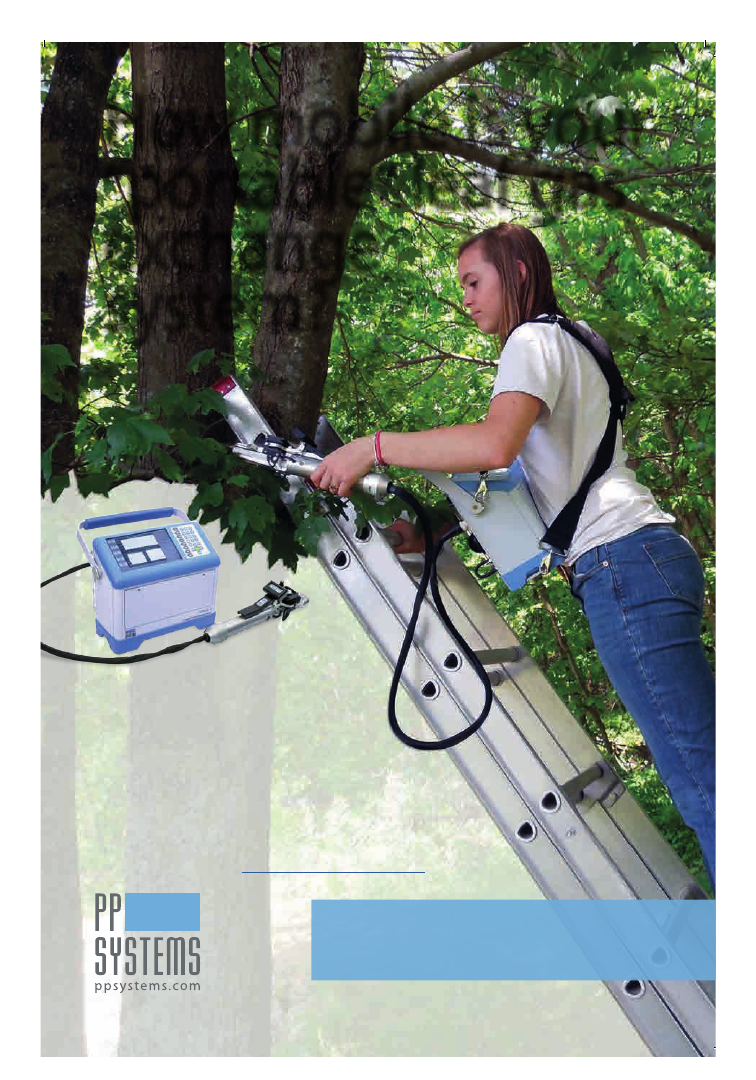
PSB 63 (3) 2017
165
How mobile is your
“
portable
”
leaf gas
exchange
system
?
110 Haverhill Rd, Suite 301 Amesbury, MA 01913 U.S.A. sales@ppsystems.com +1 978-834-0505
The CIRAS-3 is the most accurate
and mobile leaf gas exchange system
available for simultaneous measurement
of photosynthesis and chlorophyll fluorescence.
It’s renowned compact size and small system volume
provides rapid leaf equilibration and fast measurement
of photosynthesis.
Contact us to learn more
!
Interested in Rapid A/Ci Curves?
Generate them in a fraction of the time using our
innovative high-speed CO
2
ramping technique.

166
In the last issue, we shared an urgent need for
scientist mentors to work with small teams
of students on plant science investigations
through PlantingScience.org. BSA and part-
nering organization members responded to
the call, and this summer we added over 200
new mentors to our scientist mentor pool. We
are starting the fall session with 625 mentors.
PlantingScience mentors come from all career
stages with especially high numbers of gradu-
ate students (n = 224), post-docs (n = 78) and
early career scientists (n = 127) volunteering.
Our mentors include scientists from 25 coun-
tries and 48 U.S. states. Collectively, Plant-
ingScience mentors are members from 150
different societies/professional organizations
and have a diverse set of research interests
(Figure 1).
SCIENCE EDUCATION
By Catrina Adams,
Education Director
BSA Science Education News and Notes
serves as an update about the BSA’s educa-
tion efforts and the broader education scene.
We invite you to submit news items or ideas
for future features. Contact Catrina Adams,
Education Director, at cadams@botany.org.
Thanks to all of our mentors for making the
program possible and for helping get more
plant science into middle- and high-school
classrooms. Thanks also for everyone’s assis-
tance in recruiting scientists to serve as mentors.
We will be recruiting teachers heavily in
spring, so if you know of middle- or high-
school biology teachers who may be interested
in participating with their classrooms, please
direct them to our website, https://planting-
science.org/.
Teachers and Early Career
Scientists Participate in
PlantingScience Digging
Deeper Professional
Development in Colorado
Springs
This summer, 36 high-school teachers and 22
early-career scientists met at Biological Sci-
ences Curriculum Study (BSCS) headquar-
ters in Colorado Springs, CO to prepare to
participate in PlantingScience this fall using
the Power of Sunlight Photosynthesis and
Respiration Investigation Theme. Enthusiasm
was high as groups worked together to learn
how to address student misconceptions, ask
the right questions to move student learn-
Scientists Respond to Call:
PlantingScience Mentor Pool
Increases to Meet Need
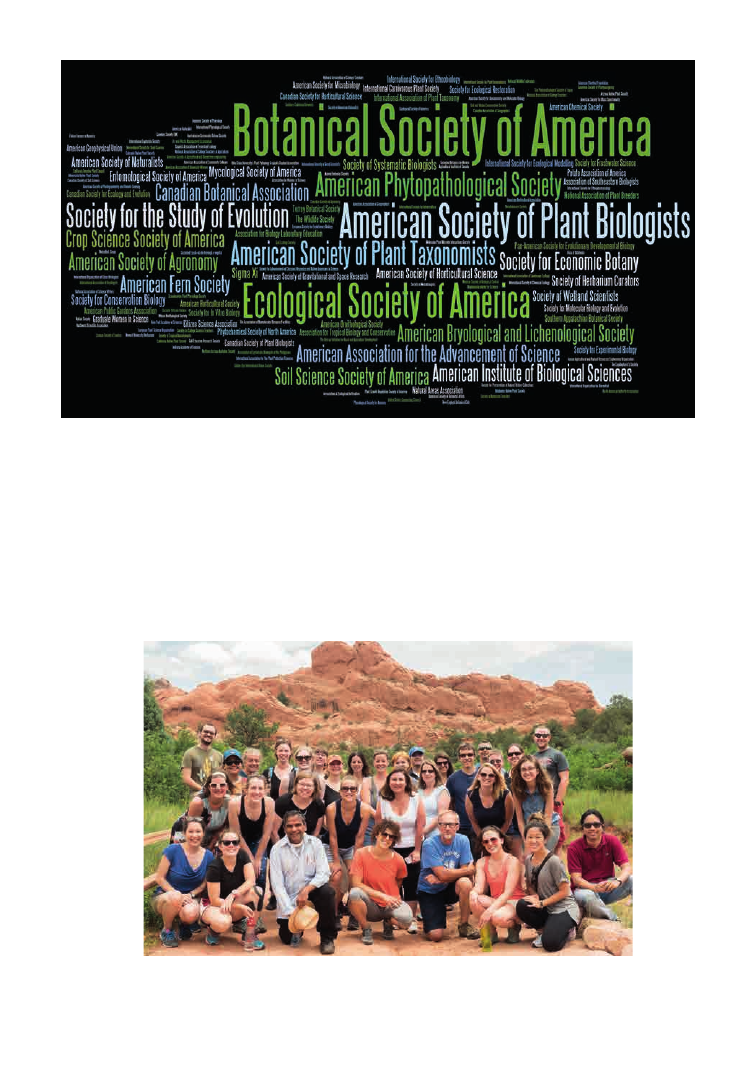
PSB 63 (3) 2017
167
Science Education
ing forward, and practice using the website
as they will in the fall. Early-career scientists
discussed mentoring strategies and how to
encourage student thinking in an asynchro-
nous, online environment, as well as how to
be good role models and encourage students’
long-term interest in science and confidence
in their science ability. The workshops are
part of the NSF-funded PlantingScience: Dig-
ging Deeper Collaborative Teacher/Scientists
Professional Development research project
(#1502892) (Figure 2).
Figure 2. Early-career scientists and teacher participants from one of two PlantingScience: Dig-
ging Deeper professional development workshops held this summer. Photo taken during the field
trip to Garden of the Gods park in Colorado Springs.
Figure 1. PlantingScience mentors collectively belong to 150 organizations. Societies with the
most PlantingScience volunteers are largest in this wordle. Notice the diversity of scientific fields
and interests represented!

PSB 63 (3) 2017
168
Upcoming Science
Education Conferences
Interested in creating environments and op-
portunities for your students to discover, in-
vestigate, and inform with data? Attend the
4
th
Life Discovery – Doing Science Biology
Education Conference October 14-21 at the
University of Oklahoma. Go to http://www.
esa.org/ldc for more information.
Attending the National Association of Biol-
ogy Teachers’ (NABT) meeting (November
9-12) in St. Louis? Please stop by to see BSA
staff at the PlantingScience booth. We’d love
to have PlantingScience mentors or teachers
stop by to share their experiences with the
program. Also check out our Inquiring About
Plants workshop with effective, tested ideas
for bringing inquiry-based teaching about
plants into your classroom. Attendees will get
a free print copy of the book “Inquiring About
Plants.” Interested in the workshop but won’t
be attending NABT this year? You can pur-
chase the e-book version ($10.95) at https://
secure.mybookorders.com/Orderpage/1400;
all proceeds go to support the PlantingScience
program.
PseudoScience Fair at the
University of Central
Arkansas is an Opportunity
to Engage Students’ Critical
Thinking and
Communication Skills
Increasing students’ ability to think critically
and distinguish between science and pseudo-
science is a main goal for many science teach-
ers. Why not approach that goal directly by
giving students opportunities to recognize and
critique pseudoscientific concepts head on?
That’s what a team at the University of Central
Arkansas aimed to do by organizing a well-at-
tended, cross-disciplinary PseudoScience Fair
through their STEM Residential College. BSA
members Steven Karafit (University of Cen-
tral Arkansas) and Faith Yarberry share their
experience of facilitating their freshman-level
biology students’ participation in the fair and
their plans for a second Pseudoscience Fair this fall.
Studying the nature of
science by investigating
pseudoscience
Students often view science as a hard and
daunting subject that is little more than mem-
orizing vast amounts of unrelated facts. It is
no secret that there is growing evidence on
the need for science faculty to not only teach
their students about the nature of science, but
also have students actively participate in the
scientific process (e.g., Alberts, 2005; AAAS,
2011). Growing evidence suggests that stu-
dents who accept pseudoscience as fact are
likely to accept other invalidated claims, such
as paranormal beliefs and conspiracy the-
ories, as facts as well (Lobato et al., 2014).
Students of the STEM Residential College at
the University of Central Arkansas were giv-
en the chance not just to learn to recognize
good science, but to research what bad science
looks like. By researching a topic that may fall
outside the sphere of science, students build
skills by finding and reading primary, peer-re-
viewed literature, analyzing data and claims,
working in groups, and explaining science to
a broad audience. This project allowed stu-
dents to research claims that may or may not
be pseudoscientific and encouraged them to
challenge their own previously held beliefs on

PSB 63 (3) 2017
169
the subject.
The STEM Residential College in Arkan-
sas Hall is a living and learning community
consisting of approximately 200 freshman
science students on the University of Central
Arkansas (UCA) campus. In the fall of 2015,
the STEM Residential College established a
Pseudoscience Fair as part of its co-curricu-
lar activities across the scholastic disciplines
of Biology, Chemistry, History, Philosophy,
Psychology, and Exercise Science. The Fall
2015 and Fall 2016 Pseudoscience Fairs were
held on the UCA campus, and approximately
400 individuals attended the event each year
from the university community and the City
of Conway.
The Resident Master of the STEM Residential
College is tasked with organizing the event.
Besides scheduling a date, time, and venue,
the primary order of business is coordinat-
ing the faculty and students. Lists of enrolled
students are obtained for the participating
classes. Students taking multiple participating
classes were placed into groups. This is an es-
sential step in the process because it encour-
ages students to view a topic through a variety
of lenses. The participating faculty members
are then brought together and topics are de-
termined for those groups that span multiple
disciplines. At the start of the fall term, the
groups are given their topic choices and the
research begins.
The STEM Residential College Resident mas-
ter assembled a list of topics for Pseudoscience
Fair participants. Topics were either generally
considered to be pseudoscience by the scien-
tific community or were at least perceived as
such by the general public. The list of topics
was deliberately broad in order to encourage
students to focus on the process and interdis-
ciplinary nature of science as recommended
by Vision and Change (AAAS, 2011).
Biology 1440
Biology 1440 (Principles of Biology 1) is a
freshman-level cellular and molecular biology
course for biology majors. It also is a required
course for several other majors to obtain a B.S.
degree. Biology 1440 is a typical lecture-based
course with a weekly 3-hour lab component.
Students were placed in groups of four to six
students. After a lecture on the nature of sci-
ence, they picked their topic of study (Table
1). In the following lecture, a librarian led the
students through the process of finding rel-
evant primary literature. Students were then
tasked to do a review of literature on the topic.
After completing their literature review, they
met with their instructor to discuss their find-
ings. Students were provided with feedback
and then had a second meeting with their in-
structor where they presented a rough draft of
their project and received additional feedback.
Students were encouraged to think critically
about the evidence that they found, and not
judge the credibility of their subject until they
had enough evidence to do so. Students were
tasked with creating a presentation or poster
that would contain the following informa-
tion: background; claims made by the prod-
uct, practitioners, or believer; evidence for or
against these claims; and a group conclusion.
Within the conclusion, students needed to
determine if their topic was scientific or not,
and they were asked to discuss what evidence
would be needed in order for the topic to be
considered as scientific.

PSB 63 (3) 2017
170
Table 1. Topics covered by Biology 1440 stu-
dent groups in the Fall 2017 Pseudoscience Fair.
The pseudoscience
fair/public outreach/student
attitudes
Participants discussed their findings with
fellow students, faculty, and the public at the
Pseudoscience Fair. The three highest scoring
groups in Biology 1440 were asked to partic-
ipate in a science outreach event at a local ju-
nior high school.
While we have collected no formal data at this
time, over 50% of students recommended that
Biology 1440 participate in the fair in the fu-
ture. Students displayed interest in their topics
and were able to take what they had learned
and apply it to other topics, including experi-
mental design in the lab portion of the course.
Future work/data collection
The participating faculty met during the sum-
mer of 2017 to discuss the organization and
evaluation of the Fall 2017 Pseudoscience
Fair. The organizers plan to develop a com-
mon survey to analyze the student opinion of
the process, along with a rubric to determine
communication effectiveness both orally and
in writing.
Literature Cited
Alberts, B. 2005. A Wakeup Call for Science Facul-
ty. Cell 123: 739-741.
American Association for the Advancement of
Science (AAAS). 2011. Vision and Change in Un-
dergraduate Biology Education: A Call to Action.
Washington D.C.
Lobato, E., J. Mendoza, V. Sims, and M. Chin. 2014.
Examining the Relationships Between Conspiracy
Theories, Paranormal Beliefs, and Pseudoscience
Acceptance Among a University Population. Ap-
plied Cognitive Psychology 28: 617-625.
Pseudoscience Fair Topics
Aromatherapy
Homeopathy
The Dangers of GMO Foods
The Health Benefits of Green Tea
Climate Change Denial
Lunar Effects on Human Behavior
Greenwashing
Vaccines and Autism
Subliminal Messaging
Electroshock Therapy

171
STUDENT SECTION
By James McDaniel and Chelsea Pretz,
BSA Student Representatives
Throughout the last decade, many botany de-
partments have become enveloped by larger
biological science departments, resulting in
fewer students pursuing botany degrees. In
order to combat this issue, many different
initiatives have taken root (e.g., using
#IAmABotanist on social media); however,
one of the most notable initiatives was BSA’s
foresight to invest in their student members.
During a time when popularity and funding
for botany related research was diminishing,
former BSA Executive Director Bill Dahl ap-
proached the board of directors with the sug-
gestion that students needed to play a more
active role in the Society by having their voices
A Reflection on the Current State
and Future Direction of Student
Membership of the BSA
heard by the rest of the Society. In fact, here is
a quote graciously provided by Dahl himself:
“There are so many passionate, tal-
ented, and energetic young botanists/
scientists looking to make a positive
contribution to science and [the] Soci-
ety in general. We needed the ideas and
energy from this group, and we need-
ed to provide a means for this to come
directly into the governance structure.
Creating positions on the board just
made sense. This has also allowed the
BSA to expose a younger group to gov-
ernance (with a window into scientific
society operations). Part of the vision
was to prepare tomorrow’s leaders by
giving people hands-on experience.
I feel this has worked well. I think all
of the past student reps would share a
similar story in terms of increased con-
fidence and growth. Remember, they
represent the Society as well as being
responsible for bringing forward new
ideas and concerns of the students to
the board for action. Having seats at the
table is important for everyone.”
Thus, more than a decade ago, the BSA real-
ized that there was a need to build a support

PSB 63 (1) 2017
Student Section
172
system for the student membership in order
for the Society to continue prospering. As a
result, two student representative positions
were established on the BSA executive com-
mittee.
More recently, at BOTANY 2016, the society
recognized a decade of service provided to
the BSA by student representatives, and we
wanted to take time to recognize this monu-
mental feat by reflecting on some of the ac-
complishments that have occurred over the
past ten years. For example, there has been a
push to establish additional resources geared
toward the student members of the BSA. Pre-
vious student representatives saw a need for
more student-oriented content at the confer-
ences, which resulted in Sunday workshops
aimed at students being added to the confer-
ence schedule. Over the past few years, stu-
dent representatives have led workshops such
as “Crafting an Effective Elevator Speech and
Communicating Broader Impacts” and “Cut-
ting the Cord: a Workshop for Computer-Free
Presentation Skills” in an effort to convey the
importance of utilizing effective science com-
munication skills when networking and/or
interviewing for jobs. Furthermore, the very
first Undergraduate Student Mixer occurred
at BOTANY 2017, which will continue to help
integrate undergraduates into the Society as
well as encourage them to attend future con-
ferences.
Another notable accomplishment within the
last ten years is the fact that the Society has
doubled the number of grants available each
year to student members. Specifically, the
Society added five new awards in 2012 and
again in 2013, which brought the total up to
19 annual grants specifically targeted toward
student membership. We are even more proud
to announce that the student awards were re-
named to honor Bill Dahl’s tremendous con-
tributions to the Society over the years, spe-
cifically those that were critical in the growth
of the student membership within BSA. The
awards are now titled the “Bill Dahl Graduate
Student Research Awards” and the “Bill Dahl
Undergraduate Student Research Awards.”
The Society has also been integral in increas-
ing diversity among the student population by
creating the NSF-funded PLANTS (Preparing
Leaders and Nurturing Tomorrow’s Scientists)
grant. The PLANTS program, which was es-
tablished in 2012, annually funds ten different
students from underrepresented groups to at-
tend the BOTANY conference. These students
are supported by a cohort of their peers as well

PSB 63 (1) 2017
Student Section
173
as two different mentors as they navigate their
first botany-related conference. Additionally,
PLANTS has been a large component when
it comes to engaging students in botany and
establishing them as active members in the
Society.
Unfortunately, one of our very own PLANTS
grant recipients, Samuel Torpey, tragically
passed away in May of 2017. As an undergrad-
uate at the University of Idaho, Samuel attend-
ed his first Botany Conference in 2014 after re-
ceiving the prestigious PLANTS grant. From
there, he finished his undergraduate degree
at the University of Idaho and became a ded-
icated student member of the BSA by serving
as a mentor for future PLANTS grant recipi-
ents. Furthermore, Samuel was a member of
the
Coeur d’Alene Tribe and enjoyed studying
his family’s native cultures while also working
as a part-time environmentalist for his tribe.
Ultimately, Samuel was a charismatic individ-
ual who had a knack for making friends and
a passion for the environment and its floral
diversity. As a result, the BSA is seeking dona-
tions to help fund a new PLANTS recipient at
BOTANY 2018 in the honor of Samuel. If you
would like to donate or to learn more, please
visit
https://crm.botany.org/civicrm/contrib-
ute/transact?reset=1&id=13.
As your current student representatives and
past recipients of the PLANTS grant, we
are excited to keep the momentum going as
student membership continues to increase
throughout the Society, but we are also excited
to focus on building an inclusive and support-
ive community for students that will last for
decades to come.
Quick Notes on the
BOTANY 2017 Conference
We would like to extend a thank you to ev-
eryone who attended BOTANY 2017 in Fort
Worth, Texas! From our perspective, the con-
ference was filled with great workshops and
mixers geared toward the student member-
ship of the Society as well as great talks given
by students, faculty, and alumni. More impor-
tantly, approximately 30% of the conference
attendees were students—a number that has
gradually increased throughout BSA’s history.
During our “Careers in Botany” Student Lun-
cheon, we were reminded by Ned Friedman to
take time to enjoy what we do and not spend
time worrying about what needs to get done
(to an extent). Friedman was also gracious
enough to show us high-speed videos of Rho-
dodendron flowers releasing pollen, which
was followed up by a nice discussion that saw
students interacting with panelists from a
broad range of botanically oriented careers.
We also had a wonderfully executed workshop
on “chalk talks,” which introduced students to
skills that are vital for giving a successful com-
puter-free presentation. After watching Mela-
nie Link-Perez present her take on a successful
chalk talk (very successful, indeed), we all had
the opportunity to practice and receive feed-
back in a friendly environment. Overall, our
student-oriented events were a success and we
loved having the opportunity to meet every-
one at the student mixer, which was hosted
at the T&P Tavern in downtown Fort Worth,
Texas.
We look forward to seeing all of you again,
or getting to know you for the first time, at
BOTANY 2018, July 21-25, in Rochester,
Minnesota!

PSB 63 (1) 2017
Student Section
174
Getting to Know your New
Student Representative:
Chelsea Pretz
Chelsea Pretz is a PhD student at the Universi-
ty of Colorado-Boulder, Ecology & Evolution
Department, and has just started her two-year
term.
When did you join BSA and what motivated
you to do so?
I first heard about the Botany Conference
during an REU (Research Experience for Un-
dergraduates) internship at Missouri Botani-
cal Garden. This was my first experience being
around so many botanists, and I came to real-
ize that research was a reachable career choice.
So many of the researchers had very fond
memories of Botany and would talk about the
conference. The next year, I was lucky enough
to be a recipient of the PLANTS (Preparing
Leaders and Nurturing Tomorrow’s Scien-
tists) grant where I was able to attend Botany
and create my own fond memories in Edmon-
ton, Canada. Furthermore, PLANTS included
a four-year membership to the BSA, which
motivated me to stay involved.
What motivated you to run for the position
of Student Representative to the Board of
Directors?
I was motivated to run for Student Represen-
tative after having such a positive experience
in the PLANTS program. During this pro-
gram, I met many different students who were
at the same place in their career and who were
excited to talk about plants. Throughout this
process I realized how lucky I was to have a
cohort of peers to experience the conference
with; however, I know that there were other
students who were isolated without a sup-
portive community of people. This realization
made me want to help connect students with
resources and help students network to meet
other really great researchers at the confer-
ence.
What is your research about?
I am studying the evolution of the genus
Physalis (Solanaceae), which contains the
important crop tomatillo. In particular, I am
investigating interspecific gene flow, pollina-
tion ecology, and reproductive isolation with
a focus on the domesticated species and their
relatives.
What sorts of hobbies do you have?
Like most botanists, I enjoy hiking, camping,
gardening, and traveling. Other things that
fill my time include sewing, listening to pod-
casts (Planet Money, Code Switch, and Re-
veal), cooking, and playing board games with
friends.

PSB 63 (1) 2017
Student Section
175
Thank You!!
PCMA POWER Chapter members Johanne
Stogran and Dianne Killian collecting supplies.
Building an Intentionally Inclusive Community
One of our main goals moving forward is to focus on building
an intentionally inclusive community for student members of
the BSA. If you have any questions, concerns, suggestions, or
comments about how we can make a more inclusive community,
please reach out to either James McDaniel (jlmcdaniel@wisc.
edu) or Chelsea Pretz (chelsea.pretz@colorado.edu).
You did a good deed!
This year at the Botany Conference we collected your unused toiletries from the Omni hotel.
Together with the Professional Convention Management Association (PCMA), we were able
to put together and donate over 400 packets of shampoo, conditioner, bath wash, and body
lotions. These will be given to families at Nationwide Children's Hospital in Columbus.

176
ANNOUNCEMENTS
Harvard University
Bullard Fellowships in
Forest Research
Annually, Harvard University awards a limit-
ed number of Bullard Fellowships to individ-
uals in biological, social, physical, and politi-
cal sciences and the arts to promote advanced
study or the integration of subjects pertaining
to forested ecosystems. The program seeks to
allow mid-career individuals to develop their
own scientific and professional growth by
utilizing the resources and interacting with
personnel in any department within Harvard
University.
In recent years Bullard Fellows have been as-
sociated with the Harvard Forest, Department
of Organismic and Evolutionary Biology, and
the J. F. Kennedy School of Government and
have worked in areas of ecology, forest man-
agement, policy, and conservation. Stipends
up to $60,000 are available for periods rang-
ing from six months to one year and are not
intended for travel, graduate students, or re-
cent post-doctoral candidates. Applications
from international scientists, women, and mi-
norities are encouraged. Additional informa-
tion is available on the Harvard Forest website
(http://harvardforest.fas.harvard.edu). Annu-
al deadline for applications is January 15.
Tenure-Track
Positions Open at Iowa
State University
The Department of Genetics, Development
and Cell Biology (GDCB) at Iowa State
University invites applications for two ten-
ure-track faculty positions at the rank of As-
sistant Professor. The department seeks to
enhance and build upon existing strengths
at ISU, with an emphasis on: (i) cellular or
developmental processes integral to animal
health or disease, especially in genetic mod-
el organisms; or (ii) cellular or developmental
mechanisms that underpin plant responses to
environmental signals and stresses.
Responsibilities include building nationally
recognized research programs that compete
successfully for extramural funding, advanc-
ing the discipline through high-quality pub-
lications, mentoring students, and effective
teaching of undergraduate and graduate
courses.
The successful candidate will possess excellent
communication and leadership skills and will
share the university’s commitment to an in-
clusive environment that supports world-class
diversity.
For more information, go to https://www.
iastatejobs.com/postings/28431.

177
BOOK REVIEWS
Bryology
Mosses, Liverworts, and Hornworts: Field Guide to Common Bryophytes
of the Northeast .......................................................................................................................................................177
Development and Structure
Trees: A Complete Guide to their Biology and Structure .................................................................179
Ecology
Venerable Trees: History, Biology, and Conservation in the Bluegrass ...................................180
Economic Botany
The Botany of Empire in the Long Eighteenth Century .....................................................................182
Sound and Scent in the Garden ......................................................................................................................184
Tulip ..............................................................................................................................................................................185
Systematics
The Botany of Mangroves, Second Edition ..............................................................................................186
BRYOLOGY
Mosses, Liverworts,
and Hornworts: Field
Guide to Common
Bryophytes of the
Northeast
Ralph Pope
2016. ISBN-13:
978-1-5017-
0078-1
Paper, US$24.95. 384 pp.
Cornell University Press
As a field botanist, I am often drawn to and
fascinated by nonvascular plants, but like so
many other botanists and plant enthusiasts,
I’ve not had much training in identifying
them and am challenged when I try to do so.
This summer, I was excited to add to my li-
brary Ralph Pope’s new field guide to mosses,
liverworts, and hornworts, a resource made
for people just like me who want to be more
versed in these diminutive plants but need
help getting there.
Pope’s guide to northeastern bryophytes is a
valuable resource for anyone who wants to
learn to identify common mosses and other
nonvascular plants in the eastern U.S. [Note:
the author acknowledges that although bryo-
phytes may not be a “proper” taxonomic term
based on contemporary understanding of
plant systematics, it is still a term often used
to refer to nonvascular land plants, and for the
sake of convenience he uses it in this way in
the book. For simplicity, I will do the same in
this review.]
The target audience for this handy and
information-rich guide is amateur naturalists
and non-bryologist botanists, and the book is
well-constructed for use by this audience—
one does not need to be highly trained in
nonvascular plants to use it. It is created with
the intention that readers can identify the
plants with only a hand lens (although some
characteristics would be more easily seen
with a dissecting microscope). He describes

PSB 63 (3) 2017
178
Book Reviews
a handy trick of putting phyllids (leafy parts
of some bryophytes) between two slides and
then holding up to the light with a hand lens to
see characters such as costa and differentiated
alar cells, which could be very useful in field
identification.
Included in the book’s introductory material
are: information about illustrations/
photographs, geographical and taxonomic
coverage, species names and ranges, basic
bryophyte biology, taxonomy, and ecology.
The introductory chapter also includes helpful
information about collecting and studying
bryophytes.
The section on bryophyte taxonomy presents
one current taxonomic delineation (stated as
one of several in use today), but unfortunately
with no citation/reference for its source
or author. The author does call out main
important points in the taxonomy of these
plants, and this is useful in understanding
current knowledge of bryophyte taxonomy,
but the systematics of nonvascular plants is
still uncertain and he notes this.
Following the introductory material, there is a
master key used to divide bryophytes into six
major groups: hornworts, thalloid and leafy
liverworts, Sphagnaceae, acrocarpous mosses,
and pleurocarpous mosses. The three moss
groups each have a section of the book with a
key to genera. In some cases (especially with
common or diverse groups), keys to species
within genera are also included. Hornworts
and the two groups of liverworts are placed
together in the final section.
The master key is very well crafted and useful.
It only gives names of major groups to lead the
reader to the next stage of the book; it would
have been more useful to also include page
numbers to lead the reader to the relevant
section. It is helpful that the keys in the
book rely as little as possible on sporophyte
characteristics as these are not always available
(although in places it was understandably
unavoidable).
At the beginning of each section on the major
groups, there is a nice, organized list of species
included. Each species description includes
specific description of its characteristics,
comparison with similar species, range and
habitat, and information about the name
etymology. Each entry is abundantly illustrated
with high-quality photos. Drawings and
photos focused on key characteristics of each
species are particularly useful. Many include
scale bars, which are incredibly helpful. Some
do not, which diminishes their usefulness,
but only slightly. Moss species entries also
include distribution maps for northeastern
U.S. south to South Carolina and Georgia and
east into Michigan (maps are not included for
liverwort and hornwort species).
An illustrated glossary is included in the back.
This glossary could use even more illustrations
of the terminology included, but it will still be
very helpful to those new to the vocabulary of
bryophyte structures. The author also includes
a list of annotated references in the back, in
five sections: those not needing a microscope;
those more technical where a microscope is
required; textbooks; miscellaneous printed
references; and websites. Readers will find
this list of resources useful for learning more
about nonvascular plants beyond what is
available in this guide.
In general, the book is very well organized and
user-friendly. The colored “tabs” indicating
the four main sections of the guide will be
very helpful in efficient use of the guide in the
field or laboratory.
Nonvascular plants can be very tricky to
identify in the field for anyone not already

PSB 63 (3) 2017
179
DEVELOPMENT AND
STRUCTURE
Trees: A Complete
Guide to their Biology
and Structure
Roland Ennos
2016. ISBN-13: 978-1-5017-
0493-2
Paper $19.95, 128 pp.
Cornell University Press,
Ithaca, New York.
For the lay public, this
is indeed a concise, but complete, guide to the
biology of trees. For professional botanists,
it is a source of interesting connections
and observations. For instance, the first
chapter is an abbreviated history of the
evolution of vascular plants highlighting
Rhynia, Lepidodendron, Calamites, tree
ferns, cycads, conifers, and angiosperms
(including monocot “trees”). Ennos notes the
rapid growth of fossil fern allies during the
carboniferous with Lepidodendron reaching
full height (about 40 m) in only 10 years.
This growth was so successful at sequestering
carbon that atmospheric CO
2
decreased from
20× the current levels at the beginning of the
period to levels lower than our current 400
ppm.
The second chapter provides an integration
of the physiology of water transport with the
“hydrodynamic design of wood.” An interest-
ing note is that hydraulic tension within the
xylem can “shrink” a 20-m-tall, 30-cm-wide
tree during the day by 1 cm in height and 1
mm in width. Among the structural features
described in Chapter 3 is a comparison of fi-
berglass to wood cell walls. However, instead
of just a structural comparison of glass fiber
and cellulose microfibrils surrounded by a ma-
trix, Ennos notes that embedding glass fibers
in a matrix increases the combined strength
1000× tougher than either component alone.
The analogous composite of cellulose and
lignin is about 100× tougher than fiberglass.
Some interesting notes on “Limits to Height”
are that stomata at the tops of tall trees close
earlier in the day than those at lower levels,
and that photosynthesis and new growth are
reduced in the upper canopy, despite greater
access to light. Chapters 5-8 focus on special-
ized groups of trees: survival strategies; trees
in different climates; specialist trees; and trees
of the southern hemisphere. My favorite “tid-
bit” from these chapters is that the “drip tip” of
rainforest trees not only help the leaf shed wa-
ter, but actually helps minimize soil erosion.
The final chapter touches on all aspects of the
economic botany of trees. My favorite exam-
ple is the physics of why the English longbow
was constructed from the join between sap-
wood and heartwood of the Yew tree. As a
result, arrows could be shot more than 100 m
and penetrate body armor.
At the end of the book is a one-page glossary,
about two dozen selected references equally
divided between books and websites, and a
useful index.
well versed in their characteristics, and there
has been a lack of easy-to-use resources for
field identification of this group. This book
helps to fill that gap. I highly recommend it
for anyone in the eastern U.S. who wants to
become more familiar with this fascinating
group of plants that are so often overlooked.
Their identification will still take careful study
and focused investigation even with this tool
in hand, but this guide will serve as a good
entry point for those new to the challenge.
-Amy Boyd, Warren Wilson College

PSB 63 (3) 2017
180
Book Reviews
My only concerns were the lack of a geological
timeline of periods and the place of families in
the hierarchy of classification, both of which
would provide a better perspective of the fos-
sil groups covered in the first chapter.
“Trees” is not quite a coffee table book, with
a 7.5- × 10-inch trim size, but it contains nu-
merous high-quality, full-color images, in-
cluding full-page images facing each chapter
title page. The format is much like a modern
textbook with a single wide column of text
and marginal figure captions. Size and place-
ment of text figures varies throughout in an
attractive way. I found the book to be a pleas-
ant read and will include it on my undergrad
reading list. I especially encourage middle-
and high-school teachers to request a copy for
their libraries. I suspect that it could provide
an effective antidote for treating plant blind-
ness.
-Marshall D. Sundberg, Emporia State Univer-
sity
ECOLOGY
Venerable Trees:
History, Biology, and
Conservation in the
Bluegrass
Tom Kimmerer
2015. ISBN-13: 978-0-
8131-6566-0
Hardcover, US$39.95. 288
pp.
University Press of Ken-
tucky
With Venerable Trees: History, Biology, and
Conservation in the Bluegrass, Tom Kimmerer
takes us on a remarkable journey that is at
once cultural and personal, wide-ranging and
intimate, challenging and inspirational. We
travel across the landscape of the Bluegrass and
Nashville Basin ecoregions, easily traversing
the years between first settlement and today,
and learn about a legacy ecosystem from a
masterful guide. Kimmerer is an ecological
detective. He pieces together physical
evidence and historical accounts of the region
to reveal the origin of the woodland pasture,
“an anomalous vegetation area” still evident
in the oldest trees alive today. Yet Kimmerer’s
account is much more than an historical or
ecological report. It is also a call to awareness,
an invitation to view the disappearance of
woodland pastures as the result of collective
choices, as well as a prescription for improved
management of our inheritance.
Our tour begins with a visit to a massive
bur oak surrounded by a parking structure
in Lexington, the sole survivor of what was
once, not too long ago, a woodland pasture
shaded by this oak and representatives of the
other four venerable tree species: kingnut,
chinkapin oak, blue ash, and Shumard oak.

PSB 63 (3) 2017
181
Kimmerer dubs the burly giant the “St. Joe
Oak” and, by naming the tree, acknowledges
the importance of its long life as a member of
a larger community that eventually included
the humans who demanded its preservation.
The St. Joe Oak, and the other named trees
and groves that grace the pages of Venerable
Trees, reminds us of a landscape that predates
human settlement and our present-day
structures, a landscape that we now glimpse
with the help of our able guide.
Large portions of the Bluegrass and Nashville
Basin, we learn, were once mosaics of
woodland pastures, forest, and meadows of
cane and grasses. The botanist E. Lucy Braun,
studying the region in the 1950s, was uncertain
of its origin, believing that the environmental
conditions there should have produced a
continuous forest. Kimmerer deftly disputes
the hypothesis that early settlers thinned the
once-dense forests and instead investigates
the interaction of several key factors over
a longer time period that encompasses the
settlement era. He weaves together natural
history and memoir, biogeography, and
dendrochronology to demonstrate that
“today’s landscape is the direct descendant
of the mosaic created by karst, drought, and
bison.” The effect of clearing, fire, and Native
American activities were not as relevant here
as in other regions of the eastern United States.
Kimmerer’s ecological analysis is the heart
of Venerable Trees. His interpretation of the
origin of woodland pastures is accompanied
by a comparison with the analogous “wood
pastures” of England. This comparison serves
to not only strengthen his analysis, but also
fuels the subsequent discussion of how best
to conserve the ancient giants and remnant
pastures that exist today. We continue touring
the landscape with visits to several locations
that exemplify good management and several
in which management was an afterthought
or development was prioritized. We see
that woodland pastures can be maintained
in agricultural areas with key changes to
animal management, and in urbanizing areas,
awareness and care can extend the lives of
isolated trees. Kimmerer uses living examples
such as the Old Schoolhouse Oak and the
Elmwood Trees to suggest several “general
rules of management” that reflect our current
state of knowledge about tree reproduction
and establishment and their susceptibility
to root damage caused by construction and
suburban lawn care.
For those of us encountering the Bluegrass
and Nashville Basin for the first time, perhaps
not having an investment of familiarity and
connection in these particular trees, we meet
with the challenge of considering how well we
know our own regional landscape. Kimmerer
indirectly asks us to consider the way in which
natural landscape elements are gradually but
permanently altered by human actions. His
words are a subtle call for an integrated human-
nature landscape and for understanding the
needs of that which we value. Many venerable
trees remain because people learned to value
the park-like atmosphere that they created in
cemeteries and preserved estates. Others were
the focus of active campaigns to protect them
during construction or to care for them after
lightning strikes or disease.
This impressive synthesis of several fields of
study is clearly the result of many decades
of research and exploration. Readers new
to these topics will find food for thought
in Kimmerer’s technical detail about mast
fruiting, dendrochronology, the effect of
lightning strikes, and range shifts in response
to climate change. The more experienced
reader may find inspiration in the author’s
thoughtful discussion of ecological
management and restoration planting. All
who appreciate trees will enjoy the dozens of

PSB 63 (3) 2017
182
Book Reviews
color photographs and the species list with
habitat notes. Just as venerable trees increase
as we move away from city centers, our view
enlarges as we move away from “what is” and
consider “what might be.”
The promise of this book’s title is fulfilled. A
venerable being, Webster’s dictionary tells
us, is one that “calls forth respect through
age, character, and attainments.” The story of
the woodland pasture trees not only evokes
a respectful awareness, but also suggests the
profound relationships we are capable of
having with long-lived species able to shelter
many generations of our own.
-By Andrea Kornbluh, Rowan University
ECONOMIC BOTANY
The Botany of Empire
in the Long Eighteenth
Century
Yota Batsaki, Sarah Burke
Cahalan and Anatole
Tchikine, Eds.
2016. ISBN-13:
978-0-
8840-2416-3
Hardcover, US$90.00,
£66.95
, €81.00. 406 pp.
Dumbarton Oaks Symposia
and Colloquia, Dumbarton
Oaks Research Library and Collection, Washington, DC.
The Botany of Empire is a lavishly illustrated
and carefully documented volume, extending
presentations from a symposium marking the
fiftieth anniversary of the Rare Book Room at
the Dumbarton Oaks Research Center. The
editors are long-time affiliates of Dumbarton
Oaks: Yota Batsaki is Executive Director;
Sarah Burke Cahalan is Director of the Marian
Library, University of Dayton, formerly special
projects and reference librarian at Dumbarton
Oaks; Anatole Tchikine is Assistant Director
of Garden and Landscape Studies, Dumbarton
Oaks. Nearly all images reproduced are from
volumes held in the Dumbarton Oaks Rare
Book Collection; if from elsewhere, they are
for purposes of comparison.
This endeavor spearheads strengthening
connections to the history of science.
It documents widespread exploration
worldwide, and derives from the massive
increase in collection of botanical specimens,
taxonomic breakthroughs, and horticultural
experimentation during the 18th century.
Contributors to this volume compare the
impact of those new developments and
discoveries as several regions broadened their
geographical possessions beyond the better-
branded British, Dutch, French, and Spanish
empires. These studies examine the botanical
ambitions of 18th-century empires; some
notable botanical explorers; links between
imperial ambition and the impulse to survey,
map, and collect botanical specimens in
“new” territories; and the relationships among
botanical knowledge, personal motivations,
and material culture. Organizationally, the
contributions are divided into four parts that
follow the Editors’ Introduction. Chapter titles
are provided here.
Part I: Botanical Ambitions, features
“Botanical Conquistadors: The Promises
and Challenges of Imperial Botany in the
Hispanic Enlightenment,” establishing that
botanical exploration was a global enterprise
with high economic stakes that relied on
institutional networks and received strong
state support in the quest for new raw
materials; “The Geography of Ginseng and
the Strange Alchemy of Needs,” wherein a
Jesuit account of Chinese ginseng published
in Paris, read by a missionary in Quebec,
led to the unlikely discovery of the plant
in North America; “Weeping Willows and
Dwarfed Trees: Plants in Chinese Gardens

PSB 63 (3) 2017
183
under Western Eyes,” communicates Jesuit
accounts showing the Chinese garden as the
product of an enlightened empire, worthy of
imitation due to its informal aesthetic and
low cost, although that view was subsequently
reversed, considering it perhaps as perverse
manipulation of nature; “Echoes of Empire:
Redefining the Botanical Garden in
Eighteenth-Century Tuscany,” offers a concise
trajectory of the botanical garden.
Part II: Agents of Empire? scrutinizes
the notion of botanist as agent of empire
through several case studies. “The Politics
of Secular Pilgrimage: Paul-Émile Botta’s
Red Sea Expedition, 1836–39,” indicates that
Botta’s success rested on his knowledge of
area languages and geopolitics, and his ability
to establish local connections and navigate
local conflicts, then highlights the extent to
which botanical practices were enmeshed in
other areas of expertise (e.g., in this example,
archaeology and diplomacy); “François Le
Vaillant: Resistant Botanist?” reveals his
criticism of botanical illustration for its two-
dimensionality, and its deplorable neglect
of indigenous knowledge of indigenous
ecosystems; “Thomas McDonnell’s Opium:
Circulating Plants, Patronage, and Power in
Britain, China, and New Zealand, 1830s–50s,”
displays how metropolitan centers connected
activities on the periphery.
Part III: Botanical Itineraries, conveys
“On Diplomacy and Botanical Gifts: France,
Mysore, and Mauritius in 1788,” tracing some
interpersonal trajectories of 18th-century
colonial botany featuring nutmeg, cloves,
and cinnamon, spices not native to France;
“From Local to Global: Balsa Rafts and a
Bountiful Harvest from Ecuador,” advances
an appreciation of river transport; “’In
Imperio Rutheno’: Johann Amman’s Stirpium
rariorum (1739) and the Foundation of
Russia’s Botanical Empire,” assesses Russian
imperialist aspirations especially where they
came in conflict with Ottoman and Safavid
neighbors.
Part IV: Cultivating Identities, includes
“Ornamental Exotica: Transplanting the
Aesthetics of Tea Consumption and the Birth
of a British Exotic,” explores the cultural
effects of tea as commodity by focusing on
how tea consumption in England penetrated
its commerce and sensory experiences;
“Allegories of Alterity: Flora’s Children as
the Four Continents,” examines Robert
Thornton’s Temple of Flora that personifies
each plant, assigning to each racial and
cultural characteristics associated with
its territory in a hierarchical scheme that
privileges Europe as the locus of culture and
power, but tainted ideological associations
with plants from Africa, America, and Asia;
“Ottoman Horticulture after the Tulip Era:
Botanizing Consuls, Garden Diplomacy,
and the First Foreign Head Gardener,”
brings to learned European audiences a
more sophisticated picture of Ottoman
culture than those found in conventional
“Orientalist” accounts; “Making ‘Mongolian’
Nature: Medicinal Plants and Qing Empire
in the Long Eighteenth Century,” contrasts
Linnaean taxonomy with its multiethnic
and multilingual form; “William Bartram’s
Drawing of a New Species of Arethusa (1796):
Portrait of a Life,” interprets Bartram’s drawing
as “a historical reflection reminding those
who might choose to interpret the young
nation—or the course of their own lives—as
the product of a revolutionary break with the
past that the present and future are, in fact,
embedded in historical relationships that are
continuous and ever-binding,” or as sculptor
Richard Berger (1997) more succinctly stated:
“History Never Lets Go.”
As with other books in this scholarly series,
the volume unearths substantial historical

PSB 63 (3) 2017
184
artworks from Dumbarton Oaks’ rare book
collections: 174 exquisite color illustrations, 6
halftones, 1 line drawing, 1 map, 1 table; each
article is thoroughly researched, evident from
the abundant endnotes; the writing is precise
and the arguments are well-defined; and it
closes with a 14-page author and subject
Index and Contributors’ biographies. Readers
who enjoy botanical chronicles, as well as
contemporary plant explorers, will appreciate
these diverse approaches that enrich our
knowledge about the historic pursuit of green
treasures.
Literature Cited
Berger, Richard. 1997. History Never Lets Go.
Plexiglas, Lights and Motors.
–By Dorothea Bedigian, Missouri Botanical
Garden, St. Louis, Missouri
Sound and Scent in
the Garden
D. Fairchild Ruggles, Ed.
2017. ISBN-13: 978-0-
8840-2422-4
Hardcover, US$65.00,
£51.95, €58.50. 362 pp.
Dumbarton Oaks Symposia
and Colloquia, Dumbarton
Oaks Research Library and
Collection, Washington, DC.
The 2014 Dumbarton Oaks symposium in
Garden and Landscape Studies was based on
the theme of sensory perception. Presentations
explored the ways that historical encounters
with sound and scent can be reclaimed, and
explained the implication of those essences
for landscape design. In what ways are plants,
gardens, and landscapes shaped to stimulate
the senses and to promote healing? The
Editor’s Introduction closes with the proposal
that the volume’s lasting contribution may be
to show the wide variety of approaches that
we can apply to the study of sensory history,
signifying that audition and olfaction have
always been important dimensions in the
experience of gardens.
Although visitors may generally consider
gardens as places for visual experiences, Sound
and Scent in the Garden explores selected,
more elusive encounters of sound and smell,
that stimulate the sensations of humans
mightily. Sounds of fountains, footsteps,
raindrops, wind, bells, and birdsongs mingle
with scents of fragrant flowers, sunbaked
soil, bitter medicinal herbs, earthy leaf litter,
humus, or mushrooms to become soothing or
stimulating, while their sources are subtle and
distant with low visibility.
Strikingly, the titles of several contributions
are evocative and poetic, e.g., “Perfuming
the Heart: A Study of a Seventeenth-Century
Perfumery Treatise from Islamic India”; “The
Scent of Power: Flowers, Fragrance, and
Ephemerality in the Gardens of Louis XIV”;
“Sounds and Scents of Monsoon in the Late
Medieval Gardens of Rajasthan”; “Lilac and
Nightingale: A Heritage of Scent and Sound at
Horace Walpole’s Strawberry Hill.”
Imagery to delight the imagination abounds
in this volume: Visitors to an ancient Chinese
garden found zither music; the recipe for
preparation of aloeswood incense (‘ūd)
instructs the reader to break up 1 kg of the best
quality aloeswood into small pieces, and soak
these pieces for three days and three nights in
rose water strengthened with petals of Rosa
damascena. The chips of aloeswood are to
be dried in the shade and later crushed very
fine. Sugar syrup, in which ambergris soaked
in rose water, and the crushed aloeswood are
combined, and the whole is set aside to cool.
Finally, small balls, each the size of a grape,

PSB 63 (3) 2017
185
are formed from this paste, dried in the shade
in a china dish, and burned when required,
to scent a space or perfume one’s apparel. The
writer observed in 1996 that this is a ritual still
practiced in Saudi Arabia and Bahrain.
The architectural element of the pavilion
features prominently in the monsoon gardens
of Rajasthan. The moonlight garden was an
essential part of all Rajput palaces, as the
gardens would mostly be enjoyed at night
in the summers and during the monsoons.
Water features were abundant: canals, tanks,
cascades, and water under pressure that
would pass with considerable force through
pipes embedded in hollow pillars of the
structure, helping to rotate iron balls to create
the artificial sound of thunder.
Water structures of the Italian Garden are
conspicuous as well, described in itineraries
from the 16th century as “murmuring,”
“whispering,” “pattering,” and “humming”
streams, in “The Expulsion of the Senses,”
which includes lavish photographs by author
Anatole Tchikine. His Appendix translates
a 1931 cultural manifesto that remains a
foundational statement of the Fascist “garden
of reason,” a product of the artistic subjugation
of nature constructed on purely rational lines.
This admirable tome was edited by D. Fairchild
Ruggles, Professor in the Department of
Landscape Architecture at the University of
Illinois, Urbana-Champaign. As with other
books in this scholarly series, the endeavor
unearths substantial historical artworks from
rare books, including the Dumbarton Oaks
collection, delivering 13 color illustrations,
113 halftone and color photos, and 4 line
drawings. Each article is well-researched,
evident from the abundant endnotes; the
writing is clear and the arguments are well-
presented; and the book closes with a 14-page
author and subject Index and Contributor
biographies. Historians who admire garden
architecture, connoisseurs of scented and
aesthetic gardens, innovative professional
landscape installers, as well as contemporary
perfumers will appreciate these diverse
approaches that deepen our learning about
the world’s botanical and cultural heritage.
–By Dorothea Bedigian, Missouri Botanical
Garden, St. Louis, Missouri
Tulip
Celia Fisher
2017. ISBN-13:
978-1-
7802-3759-6
Hardcover, £16.00. 224
pp.
Reaktion Books, London.
Celia Fisher’s Tulip
presents a concisely
written account of
various wild tulips,
from their origins in the mountains of Central
Asia, to their cultivation in the gardens of
Mughal, Persian and Ottoman rulers, and
their transfer along the silk route. Tulip is
an appropriately illustrated botanical and
cultural history of this beloved bulb. It depicts
tulip representations on a trove of art treasures
across diverse formats, including charming
patterns on tiles from Iznik, Turkey, lacquer
book bindings, bedsheets, fabric designs,
manuscripts, paintings, and the august
painting from Thornton’s Temple of Flora,
a grand scale reproduction of it adorning
the reading room of the Missouri Botanical
Garden’s Peter H. Raven Library.
Fisher is a freelance art historian and plant
specialist who has written several stylistically
popular books on natural history, plants, and
gardens in art, including “Flowers and Fruit:
National Gallery Pocket Guide (2000),” “The

PSB 63 (3) 2017
186
Medieval Flower Book (2007),” “Flowers of
the Renaissance (2011),” “Flower: Paintings
by 40 Great Artists (2012),” “The Golden Age
of Flowers: Botanical Illustration in the Age of
Discovery 1600-1800 (2013),” and “The Magic
of Birds (2014).”
Fisher’s Acknowledgements reveal that she
relied heavily on Diana Everett’s salient 2013
volume, reviewed in these pages (Bedigian
2014), from which she acquired 11 illustrations
of tulips in their natural habitats, as well as
substantial scientific details. The contents
include wild tulips; Turkish tulips; the
economics of “Tulipomania,” during which
the frenzy that rare tulips inspired among
ostentatious collectors caused an economic
bubble; links with artists’ tulips, and literature
that tulips have roused, from Dutch Masters
to Alexandre Dumas’ novel, “The Black
Tulip.” Botanists, florists, plant hunters, and
nurserymen are all are counted in brief.
Fisher’s book joins the ranks of numerous
other writings about tulips aimed at amateurs;
a subject search of non-fiction titles in
WorldCat® related to tulips uncovers 781
books, 85 serials, and 7 articles. Fisher’s
Tulip contains 107 illustrations, 104 in color,
reproduced on high-quality paper stock,
printed and nicely bound in China; it closes
with a short Timeline beginning with the year
1070 AD when Seljuk Turks began to conquer
eastern Anatolia, creating the first ceramic tiles
that feature tulips, simultaneously with the
Persian poet Omar Khayyam’s compositions
of verses in his Rubaiyat, the first literature
to mention tulips. Fisher’s Tulip can appeal
to weekend gardeners, horticulturalists,
and history buffs who admire or grow this
fashionable flower.
–By Dorothea Bedigian, Missouri Botanical
Garden, St. Louis, Missouri
SYSTEMATICS
The Botany of Man-
groves, Second Edition
P. B. Tomlinson
2016. ISBN-13: 978-1-107-
08067-6
Hardcover, US$84.99. 418
pp.
Cambridge University Press,
Cambridge, U.K.
Thirty years ago, I wrote my first grant pro-
posal to study mangroves and began an odys-
sey through mangrove ecology that continues
to this day. Six months earlier, P. B. Tomlin-
son had published The Botany of Mangroves,
which, despite scant reviews (I can only locate
two: one written by Ong Jin-Eong [1987] for
Trends in Ecology & Evolution, and the oth-
er by Alwyn Gentry [1987] for Annals of the
Missouri Botanical Garden), was welcomed
worldwide as the go-to reference for floristics,
biogeography, and especially its unified treat-
ment of, and identification guide to, “true”
mangroves and mangrove “associates.” Al-
though not a formal taxonomic monograph,
the first edition of The Botany of Mangroves
more than fulfilled its intended goal of intro-
ducing mangroves and mangrove ecosystems
(“mangal”) to a much broader audience of sci-
entists, foresters, conservation biologists, and
restorationists. I relied heavily on The Botany
of Mangroves to ground my fanciful proposals
in the reality of working in dense Belizean for-
ests of “walking trees.”
Literature Cited
Bedigian, D. 2014. Plant Science Bulletin 60(3):
170-172. The Genus Tulipa. Tulips of the World.
Diana Everett. 2013. Kew Publishing, Royal Bo-
tanic Gardens, Kew.

PSB 63 (3) 2017
187
The first edition of The Botany of Mangroves
was re-issued in a paperback edition (1994)
with minor updates in a seven-page Appen-
dix. Now, nearly a quarter-century later, the
second edition provides more comprehen-
sive updates to chapters in the first section
(“General Account”) on biogeography, shoot
and leaf systems, structural biology, and in-
teractions with people. Most notably, this first
section includes a new first chapter—“His-
torical Prelude”—reviewing Georg Everhard
Rumpf’s (a.k.a. Rumphius; 1627–1702) early
description of 19 species of true mangroves
(“Mangium legitimum”) from the Dutch col-
ony of Amboina (now Ambon Island in In-
donesia). The material in this chapter is based
on Beekman’s (2011) six-volume translation
of Rumphius’ Herbarium Amboinense and is a
most welcome introduction to the long history
of botanical explorations of mangroves (sum-
marized in Kathiresan and Bingham, 2001).
Rumphius, Tomlinson, and all other students
of mangroves recognize that “mangrove” is
not a taxonomic grouping, but an ecological
one that provides seemingly endless opportu-
nities for studying convergent evolution.
In terms of literature review and synthesis,
however, the other 10 chapters in the first
section leave much to be desired. As in the first
edition, and reflecting the author’s expertise
in anatomy, physiology, and functional
morphology, ecology and conservation are
given short shrift. A thorough review of
mangrove ecology and conservation—of
which >10,000 articles have been published
since 1987 alone—deserves its own book,
which remains to be written (excellent
reviews of that literature, uncited in The
Botany of Mangroves, include Kathiresan and
Bingham, 2001; Walters et al., 2008; Feller
et al., 2010; Sandilyan and Kathiresan, 2012;
and Lopez-Angarita et al., 2016). At the same
time, the still-burgeoning literature on other
aspects mangrove “plant science”—more than
1000 articles published 1987–2015—is only
cursorily reviewed; for his updates of new but
basic information, Tomlinson apologetically
(p. xii) relies on only a few dozen primary
articles or reviews published in the last 15 years.
The second section, occupying nearly 60% of
the book, is a detailed description of the 36
families that include true mangroves (trees
characteristically found growing in tidal
swamps that have anatomical, physiological,
and morphological specialization for living in
salt water) and mangrove associates (trees and
shrubs, and a few herbs, that grow in mangal
but are not restricted to it). These botanical
descriptions reflect systematic and nomencla-
tural changes that have occurred since 1987.
The most notable are in the Rhizophoraceae
and Avicennia (Avicennicaceae) and reflect
Duke’s (2006) treatment of Australian man-
groves. A handful of hybrids, some of which
were hypothesized in the first edition of The
Botany of Mangroves, have been confirmed
by molecular methods and are fully treated
in the second edition. Unlike in the first edi-
tion, the treatment of each family begins on
its own page, making it much easier to read.
This section easily supplants that of the first
edition as the standard reference for students,
researchers, and practitioners working with
mangroves in the field.
The Botany of Mangroves is copiously illus-
trated, but the numerous photographs and
line drawings, so crucial to identifying, un-
derstanding, and appreciating mangroves, are
a mixed bag. On the very positive side, the
second edition includes an expansive section
of 24 color photographic plates illustrating
many aspects of mangrove flora and fauna.
(Full disclosure: I took 9 of the 177 individu-
al photographs.) Mangroves are enlivened by
the stunning photographs of bark and roots;
fruits, flowers, and leaves; the unusual vivipa-

PSB 63 (3) 2017
188
rous seedlings; microscopic details of leaf and
wood anatomy; and the forests and the people
living and working in them. On the downside,
however, the line drawings and most of the
black-and-white photographs that are placed
throughout the text appear simply to have
been scanned at low resolution from the first
edition, and then enlarged to the somewhat
larger format of the second edition. The result
is a substantial fuzziness and loss of details
crucial for accurate identification of species.
Some of the enchanting humor has been lost,
too. In the first edition, but not the second,
Tomlinson quoted Watson’s (1928) descrip-
tion of Avicennia alba fruits as “resembling a
gorged leech” that “as spent swimmers, that
do cling together and choke their art.”
From Nearchus and Theophrastus, through
Plutarch, Abou’l Abass, and Rumphius, and
down to the present day, mangroves have
fascinated scholars, authors, and travelers
(Kathiresan and Bingham, 2001). Rumphi-
us (fide Beekman, 2011) admired the “man-
gi-mangi” for their ability to live in salt water
and their novel anatomy and morphology,
whereas Steinbeck (1951) referred to them
as places of “stalking, quiet murder.” Tomlin-
son’s The Botany of Mangroves is a must-read
for anyone starting out in studying mangroves
and mangal, and a key reference for all of us
actively working on these amazing plants and
the ecosystems that they build.
—Aaron M. Ellison, Harvard University, Har-
vard Forest, Petersham, Massachusetts, USA;
aellison@fas.harvard.edu
Literature Cited
Beekman, E. M. 2011. The Amboinese Herbal.
An English Translation of Georgius Everhardus
Rumphius (Georg Eberhard Rumpf, 1627–1702).
Yale University Press, New Haven, Connecticut, USA.
Duke, N.C. 2006. Australia’s Mangroves: The Au-
thoritative Guide to Australia’s Mangrove Plants.
University of Queensland Press, Brisbane, Australia.
Feller, I. C., C. E. Lovelock, U. Berger, K. L.
McKee, S. B. Joye, and M. C. Ball. 2010. Bio-
complexity in mangrove ecosystems. Annual Re-
view of Marine Science 2: 395–410.
Gentry, A. 1986. Review: The Botany of Man-
groves. Annals of the Missouri Botanical Garden
74: 460–462.
Kathiresan, K., and B. L. Bingham. 2001. Biology
of mangroves and mangrove ecosystems. Advanc-
es in Marine Biology 40: 81–251.
Lopez-Angarita, J., C. M. Roberts, A. Tilley, J. P.
Hawkins, and R. G. Cooke. 2016. Mangroves and
people: lessons from a history of use and abuse
in four Latin American countries. Forest Ecology
and Management 368: 151–162.
Ong, J.E. 2987. Mangrove systematics. Trends in
Ecology & Evolution 2: 111.
Steinbeck, J. 1951. The Log from the Sea of Cor-
tez. Penguin Books, New York, New York, USA.
Sandilyan, S., and K. Kathiresan. 2012. Mangrove
conservation: a global perspective. Biodiversity
and Conservation 21: 3523–3542.
Walters, B. B., P. Ronnback, J. M. Kovacs, B.
Crona, S. A. Hussain, R. Badola, J. H. Primave-
ra, et al. 2008. Ethnobiology, socio-economics
and management of mangrove forests: a review.
Aquatic Botany 89: 220–236.
Watson, J. G. 1928. Mangrove forests of the Ma-
lay Peninsula. Malay Forest Records 6.
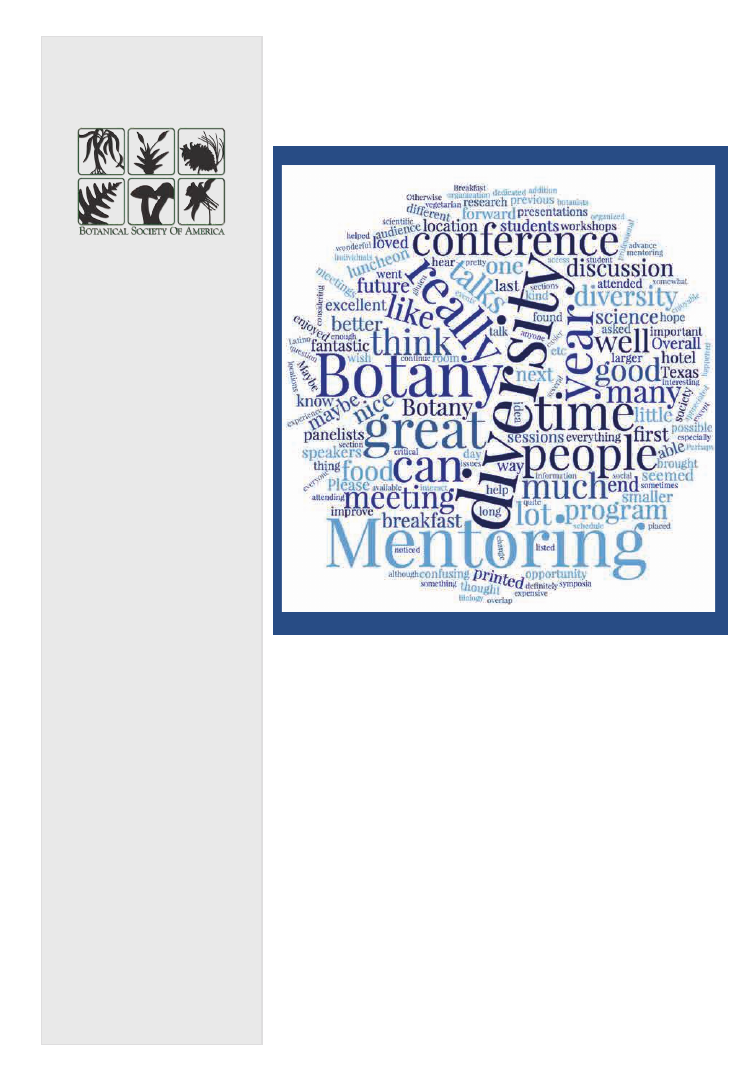
Plant Science Bulletin
Featured Image
The Botanical Society of
America is a membership soci-
ety whose mission is to: pro-
mote botany, the field of basic
science dealing with the study
& inquiry into the form, func-
tion, development, diversity,
reproduction, evolution, & uses
of plants & their interactions
within the biosphere.
ISSN 0032-0919
Published quarterly by
Botanical Society of America, Inc.
4475 Castleman Avenue
St. Louis, MO 63166-0299
Periodicals postage is paid at
St. Louis, MO & additional
mailing offices.
POSTMASTER:
Send address changes to:
Botanical Society of America
Business Office
P.O. Box 299
St. Louis, MO 63166-0299
bsa-manager@botany.org
The yearly subscription rate
of $15 is included
in the membership
Address Editorial Matters (only) to:
Mackenzie Taylor, Editor
Department of Biology
Creighton University
2500 California Plaza
Omaha, NE 68178
Phone 402-280-2157
psb@botany.org
Plant Science Bulletin
Fall 2017 Volume 63 Number 3
It was another fantastic conference!
This wordle, taken from BOTANY 2017 survey results,
displays the important factors that make our confer-
ence stand out. DIVERSITY. MENTORING. PEOPLE.
One important word that may get lost here is CAN. The
conference opens doorways for collaboration, for learn-
ing, and for camaraderie—these things CAN be possi-
ble through the work and spirit of conference attendees.
We'll see you at BOTANY 2018
in Rochester, MN
July 21-25!
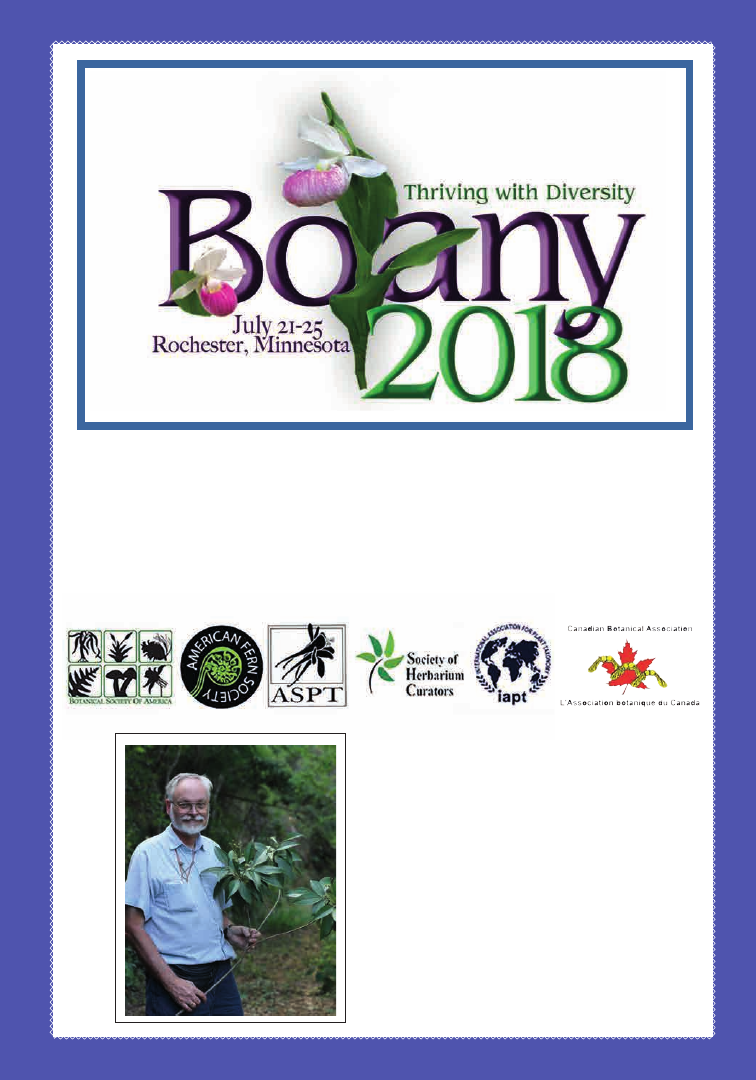
Rochester, Minnesota
Join these Societies for the
Premier Scientific Conference of 2018!
Rochester, Minnesota
July 21-25
www.botanyconference.org
Plenary Speaker
Dr. Walter Judd